 |
L400 (51332, 59484 & 51374) emerges from the west portal of Brunel's Box Tunnel on 11 April 1982. Quite what it is doing traveling between London and Bristol is a mystery, as its usual area of operation would be London and the Thames Valley. Possibly a short term transfer to Bristol? This impressive view of the ornate tunnel entrance is not so easy now as the amount of vegetation on the right hand cutting side has increased considerably. |
|
 |
In pristine condition, after a recent works overhaul, L400 (51332, 59484 & 51374) passes Hinksey Yard on 28 July 1983 with the 2A13 13:40 Oxford to Paddington. During refurbishment the former headcode box has been permanently blanked off, rather than featuring a black insert that this unit carried after the cessation of headcodes in the late 1970s. Nearly three decades after this picture was taken this viewpoint has changed little, except that the trees in the background have grown considerably. Oxford's former power station, seen here on the extreme left is no longer visible from this spot. The forthcoming electrification will ruin this well known photographic vantage point forever. |
|
 |
L400 (51374, 59484 & 51332) arrives at Charlbury on 27 August 1983 with the 2B60 16:33 Reading to Moreton-in-Marsh service. Quite why it is displaying Salisbury in the destination blind is a complete mystery. Class 117s would not normally go anywhere near Salisbury, and the London allocated ones definitely not. It is almost as if someone with too much time on their hands has deliberately wound the blind around until he found the most unlikely destination to display, just for a laugh! |
|
 |
The doyen of Class 117 Pressed Steel units, L400 (51332, 59484 & 51374) passes Evenlode with the 2B60 16:33 Reading to Moreton-in-Marsh service on 25 April 1984. This and a similar service in the morning were the only trains to call at the smaller Cotswold Line stations: Combe, Finstock, Ascott-under-Wychwood & Shipton. Note that there is some slight inattention to detail here, as the destination blind displays Oxford, through which the unit had already passed nearly an hour previously! |
|
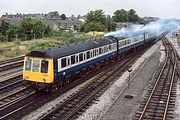 |
L400 (51374, 59484 & 51332) makes a typically smoky departure from Oxford station on 11 July 1984 with the 2A35 09:20 Oxford to Paddington service. The non stop loco hauled trains of this era did in the Oxford to London trip in well under an hour, but if you had opted for this train, the journey would have taken double that! At 1 hour 59 minutes, this was possibly the slowest way to get to London, calling at all stations en-route. |
|
 |
L400 (51374, 59484 & 51332) & L422 (59512, 51360 & 51402) pass South Moreton on 12 September 1985 with the 14:03 Reading to Oxford service. This used to be a very pleasant spot for an afternoon's photography, with only the occasional tractor crossing the farm occupation bridge, and the low bridge parapet acting as a handy seat. Unfortunately the brick bridge has been replaced with a hideous eyesore that has parapets that are way to high to see over. In addition, the electrification of the Great Western Mainline has covered this view in a mass of masts, crossbeams and wires. I suppose the rebuilding of the bridge doesn't really matter now, as no photographers will venture to this spot in the future! |
|
 |
Despite this being a picture of a humble DMU, this is one of my favourite Cotswold Line pictures. From a vantage point seldom used by other photographers, and with an uninterrupted view of Charlbury station in the background, L400 (51332, 59484 & 51374) pulls slowly away from the station with the 2A12 07:45 Moreton-in-Marsh to Reading (or Reading General according to the 1960s destination blind) service on 16 May 1986. This was one of two early morning up local services calling at all stations. |
|
 |
L400 (51332, 59484 & 51374) arrives at Moreton-in-Marsh on 5 August 1986 with the 5A12 06:43 Oxford to Moreton-in-Marsh ECS. The unit would not immediately head back south as expected, but would use the crossover in the station to access the up line, and then set back into one of the two sidings (both since lifted), to await the arrival of the loco hauled train from Hereford. It would then follow this as the 2A12 07:45 Moreton-in-Marsh to Reading. |
|
 |
This picture is not quite what it seems at first glance. Despite the red tail lights, and empty cab, this unit is actually travelling towards the camera at this point! L400 (51374, 59484 & 51332) had just arrived at Moreton-in-Marsh on 5 August 1986 with the 5A12 06:43 ECS from Oxford, and is here using the crossover from the down to the up line, in order to access the siding on the right. Although obviously there is nothing in the way, the train is being driven virtually blind, from the rear cab! It will wait in the siding on the right until after the 1A10 06:00 Hereford to Paddington has passed through, and will then form the 2A12 07:45 Moreton-in-Marsh to Reading. |
|
 |
After arriving at Moreton-in-Marsh on 5 August 1986 with the 5A12 06:43 ECS from Oxford, L400 (51374, 59484 & 51332) backs into the up siding to wait for 47619 to pass, before heading back down the Cotswold Line with the 2A12 07:45 Moreton-in-Marsh to Reading. It had just crossed over from the down main line, being driven from the rear cab. |
|
 |
L400 (51332, 59484 & 51374) arrives at Moreton-in-Marsh station on 18 October 1986 with the 2C72 09:23 Oxford to Hereford service. Although the bullhead track has gone, along of course with the Class 117 DMUs, virtually everything else in this view is largely unaltered, with just a few modern additions, such as travel information screens. |
|
 |
L400 (51332, 59484 & 51374) passes Churchill Heath on 23 April 1987 with the 2B60 16:40 Reading to Moreton-in-Marsh Network SouthEast service. This was the evening local service, calling at all stations on the Cotswold Line. Just beyond the wood in the background there is a small quarry that runs alongside the railway, presumably used to excavate material when the railway was constructed by the Oxford, Worcester & Wolverhampton Railway ion the 1850s. |
|
 |
L400 (51374, 59484 & 51332) passes Walton Well Road, Oxford, on 13 May 1989 with the 2C19 07:59 Bicester Town to Oxford Network SouthEast service. This was the first time that I saw this particular unit sporting its new NSE livery, which judging by the clean condition (especially of the roof) hadn't long been applied. Nowadays this train would use the relief line on the extreme right, therefore completely keeping clear of the main line. As Oxford North Junction is located just past Aristotle Lane footbridge in the background, I'm surprised it took them another two decades after this picture was taken to implement this simple improvement. |
|
 |
Islip station, on the Bicester to Oxford line was reopened by Network SouthEast on 13 May 1989. L400 (51374, 59484 & 51332) & Class 101 L207 (51221 & 54396) are pictured departing from the station with the first up service - the 12:27 Bicester Town to Oxford. The station has probably never been as busy since, with numerous local people gathering on the platform to witness the event, which included several stalls and a group of Morris dancers! The station was originally opened by the LNWR, but closed on 30 December 1967, when all passenger trains on the route were withdrawn. Network SouthEast had reinstated the Oxford to Bicester service in 1987, but Islip had to wait a further two years before their station was reopened. |
|
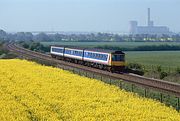 |
L400 (51332, 59484 & 51374) approaches Culham on 29 April 1990 with the 10:10 Didcot Parkway to Oxford Network SouthEast 'all stations' service. A misty morning, but whilst the background is disappearing into the haze, at least the foreground field of oilseed rape really stands out. |
|
 |
L400 (51332, 59484 & 51374) passes Ruscombe in the rain on 28 March 1992 with the 2A29 10:40 Reading to Paddington Network SouthEast service. After shuttling backwards and forwards on this line with suburban services out of Paddington since 1959, this unit would soon be off to pastures new, being replaced by the then new Class 165 Turbo units. It would first go to the North Downs line, and then, with the centre vehicle removed, to the Bedford to Bletchley line. |
|
 |
L400 (51332, 59484 & 51374) approaches Wolvercote Junction on 11 June 1992 with the 2C60 17:05 Reading to Banbury Network SouthEast service. After over three decades of working local trains in the Oxford area, L400, along with the rest of the 117s would shortly be ousted by the then new Class 165 Turbo units. L400 would first of all migrate to the Reading to Guildford route, and then, after losing its centre car and being renumbered L700, it would end its day's on the Bedford to Bletchley line. |
|
 |
L400 (51374, 59484 & 51332) accelerates away from Wokingham station on a slightly foggy 2 January 1993 with the 11:05 Reading to Guildford Network SouthEast service. I have got very few pictures of Class 117s on this route, as there was always a ready supply of them on the much nearer to home Cotswold Line, and on the Oxford to Paddington stopping trains. |
|
 |
Golden early morning winter light at Kempston Hardwick on 24 December 1996. L700 (51332 Marston Vale & 51374) approach the diminutive station with the 08:50 Bletchley to Bedford service. 51332 had been named Marston Vale a month earlier to mark the 150th anniversary of the route. The nameplate can just be seen at the rear of the vehicle. Both the DMU and the brickwork chimneys in the background are now history. |
|
 |
After being replaced on Thames Valley services by Class 165 & 166 Turbo units in 1993, L400 (51374, 59484 & 51332) found further employment working on the Bedford to Bletchley route. For this purpose it lost its centre car and was renumbered as L700. In this condition it is seen passing under the A421 Bedford by-pass at Kempston with 51374 leading, and the recently named 51332 Marston Vale at the rear, on the 09:40 Bedford to Bletchley service on Christmas Eve 1996. Luckily the impending holiday ensured there wasn't the usual procession of lorries crossing the bridge! The redundant centre trailer car was scrapped at Gwent Demolition at Margam in 1995, and the two remaining vehicles pictured here were both withdrawn in April 1999 and almost immediately cut up at MC Metals, Glasgow. |
|
 |
The 2B08 06:04 Reading to Great Malvern service was booked to stand at Moreton-in-Marsh for ten minutes in the 1982/3 timetable. On Saturday 9 April 1983, L401 (51333, 59485 & 51375) waits for the correct departure time at the deserted station. Although nobody would probably take any notice of Oxford being displayed on the destination blind at the rear of the train, the fact that Moreton-in-Marsh was being shown at the front was equally unhelpful for passengers wanting to travel further north! |
|
 |
L401 (51333, 59485 & 51375) passes Oxford North Junction on 12 February 1985 with what is presumably either a relief working, or a short term plan empty stock movement. Either way, it doesn't appear in the working timetable. This wide view clearly shows the route of the former LMS line into Oxford, which at this time was just a wide area of open ground running parallel with the former GWR route. The single track line to Bicester can just be seen turning onto the old route by the poplar trees in the background. |
|
 |
L401 (51333, 59485 & 51375) approaches Hinksey Yard on 12 February 1985 with the 2C18 14:03 Reading to Oxford service, just as 08946 runs into the up loop, prior to branching off at Kennington Junction, whilst en-route to Morris Cowley. |
|
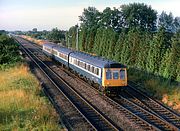 |
The 2B50 06:04 Reading to Worcester Foregate Street service arrives at Moreton-in-Marsh on 5 August 1986. L401 has had DMS 51375 removed, and its place taken by Class 121 55023 (L123). The combination now being: 51333, 59485 & 55023. |
|
 |
Still accelerating away from Goring station (just around the curve in the background), L401 (51375, 59485 & 51333) heads up the Thames Valley on 13 September 1986 with the 07:49 Paddington to Didcot Parkway service. The next hourly local service did indeed go to Oxford, but the destination blind on L401 is a little optimistic! |
|
 |
There is still a little of the previous week's snow lying next to the tracks at Cholsey on 31 January 1987, as L401 (51375, 59485 & 51333) rattles along the up relief line with the 14:21 Oxford to Paddington Network SouthEast service. This train would run non-stop from Oxford to Didcot, and then become an 'all stations' service for the rest of its journey, taking over two hours to reach the capital. In contrast, the Class 50 hauled express services at the time did it under an hour! |
|
 |
It wasn't much use taking any notice of DMU destination blinds in the Oxford area in the 1980s! However this was probably understandable here as L401 (51333, 59485, & 51375) is forming a hastily organised Oxford to Reading relief service due to the late running of 47515 on an inter regional service. Even in normal circumstances it was quite common to see units displaying a destination that they had either just come from or was at least in the opposite direction! 14 March 1987. |
|
 |
L401 (51333, 59485, & 51375) arrives at Oxford station's platform 1 on 25 September 1987 with the ECS that will form the 2C07 07:36 Oxford to Reading Network SouthEast service. Then, as now, there were carriage sidings on both sides of the lines just to the north of the station. |
|
 |
A train of new concrete sleepers occupies one of the lines in the foreground, as L401 (51375, 59485 & 51333) passes Hinksey Yard on 14 April 1988 with the 2C27 12:43 Oxford to Reading Network SouthEast service. The only other occupants of the yard are a few odd wagons that have presumably been detached from the local Speedlink trip workings. |
|
 |
L401 (51333, 59485, & 51375) pulls away from a deserted Oxford station on Sunday 20 August 1989. Note the framework for the new station building being constructed on the right. This is a bit of a mystery working, and I can only assume it is a last minute DMU substitute for the 1F04 09:30 Oxford to Paddington loco hauled service, presumably cancelled due to a loco failure. In this instance the Didcot destination blind is correct, because it certainly didn't go the capital, as it was back in Oxford in time to work its next booked train - the 11:00 to Didcot. |
|
 |
Oxford is justifiably world renowned for its fine architecture, but until the 1990s rail travelers from London were greeted with this as their first view of the city as their train arrived at Oxford station. A Hillman Avenger, Morris Marina, Mini and other 1970s cars meet their end in the scrapyard on the site of the old goods yard, as L401 (51333, 59485, & 51375) leaves the station with the 2C23 11:00 Oxford to Didcot Network SouthEast service on 20 August 1989. The cars at this location nowadays are hopefully in better condition, as it is now the station car park. |
|
 |
L401 (51375, 59485 & 51333) passes Colthrop on 30 September 1989 with the 2B18 10:10 Reading to Bedwyn Network SouthEast service. This is the only picture I have at this location taken before the field on the left was developed into a large industrial estate. The footbridge from which this was taken has now been removed. |
|
 |
Still accelerating away from Hungerford station, L401 (51333, 59485 & 51375) passes underneath the roadbridge at Hungerford Common on 30 September 1989 with the 2B33 12:59 Bedwyn to Reading Network SouthEast service. |
|
 |
L401 (51375, 59485 & 51333) passes Shottesbrooke on 29 October 1989 with the 2F20 07:40 Paddington to Reading Network SouthEast service. This was one of a number of excellent photographic locations between Maidenhead and Reading, all of which have been sadly lost due to the electrification of the route. However, as can be seen here, apart from in the summer, trains had to be on the relief lines in order to guarantee being free of shadows. |
|
 |
L401 (51333, 59485 & 51375) passes through Iver station on 22 February 1990 with the 2A59 15:40 Reading to Paddington Network SouthEast service. Note the isolated section of rail near the road, presumably the last remnant of the short branch that one led to a nearby gravel pit. In the far distance is a farm occupation bridge which used to be an excellent photographic location, but has now been demolished. |
|
 |
L401 (51333, 59485 & 51375) pulls away from Radley station on 1 May 1990 with the 17:56 Reading to Oxford Network SouthEast service. Radley station was formerly the interchange station for the Abingdon branch, which explains the disused platform face on the right of this picture. |
|
 |
L401 (51333, 59485 & 51375) & L423 (51361, 59513 & 51399) approach Bicester Town station with the Oxon & Bucks Rail Action Committee 07:00 Oxford to Spalding (via Fenny Stratford and Bedford) special on 2 May 1992. In addition to a day out which took a pair of Class 117s well away from their home territory, this train was run to highlight the possibility of reopening the Oxford to Milton Keynes line for through passenger services. Finding a clear viewpoint that shows the whole train at 07:20 in the morning on the Oxford to Bicester line is not as easy as it would seem, and although this location from the then newly completed A41 Bicester southern bypass does provide an excellent position, it does unfortunately include Bicester sewage works in the background! |
|
 |
117724 (51333 & 51375) passes Forders Sidings on 17 September 1996 with the 08:40 Bedford to Bletchley service. This unit had spent most of its working life working local trains out of Paddington, at which time it operated as a three car unit. Almost exactly ten years earlier I had photographed it on one such working near Goring. |
|
 |
117724 (51333 & 51375) passes the lake at Kempston on 24 December 1996 with the 09:50 Bletchley to Bedford service. The embankment in the background is the A421 Bedford bypass. The Marston Vale line was the final home to a number of the Class 117s units, although by this date they had lost their centre vehicles. |
|
 |
In the last rays of the setting sun, 117724 (51333 & 51375) arrives at Ridgmont with the 18:40 Bedford to Bletchley service on 4 June 1997. Formerly Thames Valley set L401, it was ousted from its Paddington duties by the arrival of the Class 165 Turbos in 1992. At this point it lost its centre trailer and was renumbered 724. At the very end of its career, it was obviously decided to incorporate the class designation in the number, in a similar way to the units that had moved to the Provincial sector, therefore becoming 117724. |
|
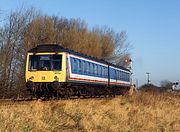 |
The level crossing barriers lift behind 117724 (51375 & 51333) as it passes Forders Sidings on 12 December 1997 with the 10:40 Bedford to Bletchley North London Railways service. 117724 was London allocated three car set L401 in a previous life. |
|
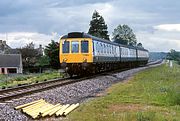 |
L402 (51335, 59487 & 51377) comes off the double track section of the Cotswold Line at Ascott-under-Wychwood on 17 June 1980 with the 5A09 19:15 (in theory!) Moreton-in-Marsh to Oxford ECS. This was running almost an hour early, which meant that rather than waiting at Moreton for the booked 58 minutes, after arriving with the 2B48 15:29 Paddington to Moreton-in-Marsh, it must have left straight away! Also, note that the guard appears to be standing up in the cab and displaying a red flag to the signalman. I've no idea this many years later what that was about. |
|
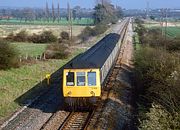 |
L402 (51377, 59487 & 51335) has just passed the site of Yarnton Junction on 15 April 1983, and is heading up the Cotswold Line with the 2B60 16:33 Reading to Moreton-in-Marsh service. An idea of just how remote Yarnton Junction station was can be gauged from this view, as in the 1980s the area was relatively clear of trees. The Scots pines in the background mark the site of the station, and it is immediately apparent that there are no buildings anywhere near it. The station was purely an interchange point for the Fairford Branch, the route of which diverged to the right on the far side of the long grass behind the electricity pole. |
|
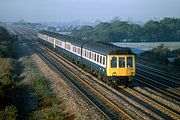 |
A pair of Reading allocated Class 117s well away from their usual patch on 27 October 1984. L402 (51377, 59487 & 51335) & L415 (51351, 59503 & 51393) pass Marshfield with the late running 08:48 Cardiff Central to Weston-super-Mare service. Both of these units would normally operate Thames Valley services out of Paddington, with Bristol or Cardiff units being more normal in South Wales. Obviously there would be a number of people going to Bristol on a Saturday morning, but six coaches through to Weston in the autumn is probably an extravagance! |
|
 |
In sparkling ex-works condition, after its repaint into Network SouthEast livery, L402 (51335, 59487 & 51377) accelerates away from West Drayton station on 6 November 1986 with the 2A33 09:26 Slough to Paddington 'all stations' service. Just behind the builder's yard on the right is an earlier form of transport - the Grand Union Canal. |
|
 |
L402 (51377, 59487 & 51335) passes Churchill Heath on 23 April 1987 with the late running 2A56 16:46 Hereford to Oxford Network SouthEast service. As was often the case on the Cotswold Line, the destination blind is incorrect. However, at least Didcot is in the immediate area, unlike Salisbury, which I photographed on a Reading to Moreton-in-Marsh train in 1983! |
|
 |
L402 (51377, 59487 & 51335) & L420 (51400, 59510 & 51358) arrive at Bicester Town on 9 May 1987 with the inaugural Network SouthEast service from Oxford. After being a freight only line for two decades, this was the start of the passenger renaissance on this line, which now sees a half hourly service to London via the Chiltern Line, something that would have not seemed at all likely back in 1987. Note the wood yard on the right, totally unfenced, and right next to the running line! |
|
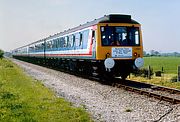 |
L402 (51377, 59487 & 51335) & L420 (51400, 59510 & 51358) pass Oddington on 9 May 1987 with the 13:25 Oxford to Bicester Town Network SouthEast special. This location has now changed out of all recognition, with the vintage bullhead track replaced by a reinstated high speed double line. The level crossing from which this picture was taken has been replaced by a bridge a little further to the north. Even before all this alteration, the scene had changed considerably, as trees were planted next to the line in the former crossing keeper's garden on the right. |
|
 |
L402 (51377, 59487 & 51335) & L420 (51400, 59510 & 51358) approach Oxford North Junction on 9 May 1987 with the 15:25 Oxford to Bicester Town Network SouthEast special, one of a series of trains celebrating the reopening of the line to passengers. |
|
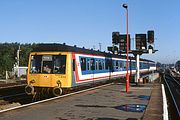 |
L402 (51377, 59487 & 51335) arrives at Oxford station form the carriage sidings on 25 September 1987, ready to form the 2C17 08:57 Network SouthEast service to Reading (despite what the destination blind says!). This was running a few minutes late, after having to wait for a late running train from Hereford. |
|
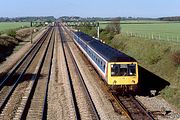 |
L402 (51377, 59487 & 51335) runs along the up relief line at Waltham St Lawrence on Sunday 8 April 1990 with the 2A34 09:15 Reading to Paddington Network SouthEast service. On this occasion it was not just the DMUs that were using the relief lines, as engineering work had closed the two fast lines on the left. |
|
 |
L402 (51335, 59487 & 51377) approaches Walton Well Road, Oxford, on 8 September 1990 with the 2C19 08:05 Bicester Town to Reading Network SouthEast service. In the background, 56043 gets underway with its loaded stone train, bound for the nearby Banbury Road stone terminal. |
|
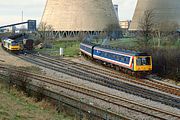 |
L402 (51335, 59487 & 51377) comes off the flyash loop at Didcot Power Station on 20 February 1993, after traversing the site with the Branch Line Society's 'Thames & Chiltern Rambler' railtour. At least one tour participant is getting a picture of 60069 Humphry Davy waiting to leave with the 6E13 12:15 Didcot to Barrow Hill MGR empties. The railtour had originated from Bishops Stortford (a very unusual location for a Reading based DMU such as L402), and then travelled to the West London area, for the first freight branch highlight - the Park Royal Guinness branch. It then travelled via the Chiltern Line to the UKF fertilizer depot at Akeman Street, before coming to Didcot via the Bicester to Oxford line. |
|
 |
L402 (51335, 59487 & 51377) accelerates away from Pangbourne station on 28 April 1993 with the 2C58 17:23 Reading to Oxford Network SouthEast service. This was an excellent location for photography, admittedly mainly for trains on the relief lines, but it has been many years since it was possible to access this spot. |
|
 |
To mark the official closure of the already virtually disused Claydon Junction to Bletchley section of the Oxford to Bletchley route, the Oxford & Bucks Rail Action Committee in association with the Bucks Herald newspaper, ran a special train from Princes Risborough to Spalding on 1 May 1993. Although the destination was the famous flower festival, the main reason for the crowds seen here at Winslow was that local people were taking advantage of the last chance to travel by train from their local station. Unfortunately the station building, which had been derelict for a long time, was demolished just a few weeks previously. The tour was also billed as a Class 117 DMU farewell, as the units were rapidly being ousted by the newly built Class 165 & 166 Turbos. At 08:05 on a slightly mist morning, L402 (51335, 59487 & 51377) & L405 (51381, 59491 & 51340) arrive to pick up the waiting passengers. |
|
 |
L403 (51336, 59488 & 51378) approaches Charlbury on 27 March 1982 with the 2A29 13:30 service from Hereford. As this was a Saturday, this train would terminate at Reading, whereas on a weekday it would continue on to Paddington. At this time there were still several loco hauled trains on the Cotswold Line, with DMUs normally confined to the local workings. I wonder if anyone ever used this train to travel all the way from Hereford to London, or instead retimed their journey to use one of the quicker Class 50 hauled trains? |
|
 |
L403 (51336, 59488 & 51378) & L572 (51082, 59540 & 51054) approach Culham on 5 May 1984 with the 2A36 13:01 Paddington to Oxford service. There was obviously some rostering variation in operation on this day, as instead of returning directly with the 2A21 from Oxford, that job was entrusted to L411. Also, while the formation of L572 is technically correct for the period, a quick glance at the original Kodachrome slide reveals too many door hinges on the centre trailer! Therefore it looks like 59540 has been temporarily replaced by a Class 117 trailer. |
|
 |
A misty morning at Froxfield on 20 June 1984, as L403 (51336, 59488 & 51378) runs alongside the Kennet & Avon Canal with the 2A08 06:39 Paddington to Bedwyn. As the canal was not yet open to through navigation at this time, there is little to disturb the rampant growth of the native Yellow Water Lily (Nuphar lutea). |
|
 |
L403 (51378, 59488 & 51336) stands in the snow at Moreton-in-Marsh station on 16 January 1985, after having arrived with the 2B72 16:35 'all stations' service from Reading. It would wait here for an hour before returning south as the 2A50 19:20 to Paddington. |
|
 |
L403 (51336, 59488 & 51378) leaves Oxford station on 1 August 1986 with the 2A12 07:45 Moreton-in-Marsh to Reading Network SouthEast service. This was one of two early morning trains that called at all of the Cotswold Line stations (including the diminutive former GWR wayside halts at Finstock and Combe). This gave these stations a 100% better service than they receive nearly three decades later! |
|
 |
L403 (51378, 59488 & 51336) arrives at Kingham station on 2 August 1986 with the 2B20 17:15 Didcot Parkway to Moreton-in-Marsh Network SouthEast service. The disused platform on the left of this picture was used by Cheltenham to Banbury trains, the bridge giving access to the mainline to the south of the station. |
|
 |
Shortly after sunrise on 10 September 1986, L403 (51378, 59488 & 51336) accelerates away from Kingham station with the 2B50 06:04 Reading to Worcester Foregate Street Network SouthEast service. I particularly like the way the very low sun is tinted the track red. Photo taken from a public footpath crossing. Unfortunately there is no way you could take a picture here this early in the morning nowadays, as trees now shade the line. |
|
 |
A view of Hinksey Yard on 27 September 1986, before it became the busy 'Virtual Quarry' ballast dump that it is today. It is also before the trees between the railway and the lake partly obscured the view of the spires of Oxford in the distance. L403 (51378, 59488 & 51336) passes by the lines of abandoned vans and ZHV open wagons, as it nears its destination with the 12:49 Paddington to Oxford Network SouthEast service. |
|
 |
A Class 117 & 119 DMU combination at Langley on 6 November 1986. Pressed Steel Class 117 suburban unit L403 (51336, 59488 & 51378) is paired with Gloucester Railway Carriage & Wagon Company Class 119 cross country unit L576 (51062, 59421 & 51090), as they work the 12:49 Paddington to Oxford Network SouthEast service. |
|
 |
Soft early morning winter light at Chilson on 13 December 1986. L403 (51378, 59488 & 51336) works the 2B52 09:23 Oxford to Hereford Network SouthEast service. Unfortunately this wide open view, with the village of Chadlington clearly visible in the background, is a thing of the past. Virtually no lineside bush clearance was done here with the reinstatement of double track, and therefore this location is now totally obscured by vegetation. So bad is it that one bush appears to be shaped in outline by the passage of trains! |
|
 |
A scene that is now history. Chinnor cement works in the background has now been demolished, and the former Chinnor station has been rebuilt near the passing loop in the middle distance, as the route is now a preserved line operated by the Chinnor & Princes Risborough Railway. On 11 June 1988, when the branch was still open for coal traffic to the cement works, L403 (51336, 59488 & 51378) & Class 121 trailer 289 (54289) leave the site with the RCTS 'Chinnor Railtour', which also visited the Brentford GLC Refuse Transfer branch and the Morris Cowley line at Oxford. Strangely, the two unpowered vehicles here (the Class 117 centre car and the Class 121 trailer) have survived, whilst both DMU power cars have been scrapped. |
|
 |
L403 (51336, 59488 & 51378) & Class 121 54289 (289) pass Blackbird Leys on 11 June 1988 with the RCTS 10:32 Paddington to Morris Cowley 'Chinnor Railtour'. As the name implies, the train had also visited Chinnor Cement Works. The oil depot on the right has now been swept away, and replaced with yet more houses. |
|
 |
L403 (51378, 59488 & 51336) passes the then recently built Foundation Park industrial estate, White Waltham, on 6 January 1991 with the 2A42 11:15 Reading to Paddington Network SouthEast service. After L403 was displaced from the Thames Valley duties in late 1992, it was reformed as two car unit L708. |
|
 |
With Didcot Power Station dominating the background, L403 (51378, 59488 & 51336) approaches Culham on 2 August 1991 with the 2C26 09:00 Reading to Oxford Network SouthEast service. The power station was closed in 2013, and has now been demolished. |
|
 |
L403 (51336, 59488 & 51378) passes South Moreton (Didcot East) on 29 January 1992 with the 2C33 12:45 Didcot Parkway to Reading 'all stations' Network SouthEast service. The DMU would soon be replaced on these trains by the new Class 165s. Didcot Power Station, which can be seen in the background, had slightly longer left, surviving for another two decades. |
|
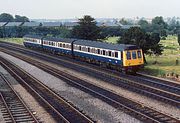 |
L404 (51379, 59489 & 51337) arrives at Oxford on 17 June 1984 with the 2A28 06:19 Paddington to Oxford 'all stations' service. It is interesting to note that there are five operational lines in this picture, whereas now there are only three. The two lines on the left served the scrapyard, which was situated where the station's car park now is. |
|
 |
L404 (51337, 59489 & 51379) passes Oxford North Junction on 5 September 1984 with the 2A79 07:45 Moreton-in-Marsh to Didcot service. It is just crossing the well used footpath that leads from Aristotle Lane to the Trap Ground allotments, which can be seen on the left. |
|
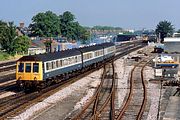 |
L404 (51379, 59489 & 51337) leaves Oxford station on 2 July 1985 with the 2C07 09:53 departure for Paddington. Waiting in the station's centre road is 47240, which will follow the unit with the 4V16 09:33 Washwood Heath to Morris Cowley empty car carriers. |
|
 |
L404 (51379, 59489 & 51337) passes Hinksey Yard on 4 July 1985 with the 2A41 10:57 Oxford to Paddington service. After a profitable morning's photography, the light was now getting very head on, so it was time to move on. |
|
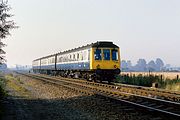 |
L404 (51379, 59489 & 51337) approaches Appleford on 12 September 1985 with the 5B60 09:06 Didcot Parkway to Oxford ECS. As this became the 2B60 09:23 Oxford to Hereford service, one can't help wondering why it didn't just start carrying passengers from Didcot! It had arrived at Didcot a little earlier as the 2A12 07:43 Moreton-in-Marsh to Didcot. |
|
 |
L404 (51379, 59489 & 51337) passes Cassington on 16 May 1986 with the 2B60 16:40 Reading to Moreton-in-Marsh service. It will shortly being calling at Hanborough station, and will then stop at all the Cotswold Line stations, therefore taking nearly 50 minutes to cover the 28 miles from Oxford to Moreton. The large white building visible in the distance is Oxford's John Radcliffe Hospital. |
|
 |
Rush hour at Finstock on 10 April 1987! Six passengers get ready to board the 2A12 07:45 Moreton-in-Marsh to Reading Network SouthEast service, worked by L404 (51379, 59489 & 51337). Although this diminutive wayside halt was only served by three trains a day in 1987, that is still 50% better than today's service of just one train in each direction. In 1987 there was an additional early morning southbound working - the 2A04 06:10 Moreton-in-Marsh to Oxford. The station had just been reconstructed on the opposite side of the line, allegedly to avoid passengers having to cross the busy road bridge. |
|
 |
Charlbury station, pictured from a slightly unusual angle on 8 May 1987. L404 (51379, 59489 & 51337) leaves the station with the 2B52 09:27 Oxford to Hereford service. The car park is extremely full by 1980s standards, although nothing like the current situation, where the several times extended car park is full to capacity by early morning. Of note is the selection of now classic cars, including a Saab 99 and Sunbeam Alpine in the foreground. However, the Bentley in the background was very old even then! |
|
 |
L404 (51337, 59489 & 51379) approaches Kingham on 8 May 1987 with the 2A50 15:44 Great Malvern to Didcot Parkway service. In the foreground is the public footpath crossing that links the villages of Kingham and Bledington. The vintage bullhead track seen here would last nearly another decade. Even in the 1980s it was unusual for this type of track to still be in place on a double track mainline in England. |
|
 |
L404 (51379, 59489 & 51337) approaches Oxford North Junction on 13 May 1987 with the 2C08 07:20 Oxford to Bicester Town Network SouthEast service. As the reinstated service to Bicester had only commenced four days earlier, there is some excuse for the incorrect Oxford destination being displayed. Presumably the Reading based Class 117s were not yet equipped with destination blinds that included Bicester Town. |
|
 |
L404 (51337, 59489 & 51379) passes Oxford North Junction on 13 May 1987 with the 2C13 08:05 Bicester Town to Reading Network SouthEast service. This was a bit of a novelty at the time, as passenger trains to Bicester had only been reintroduced four days earlier. |
|
 |
Class 117s had effectively been ousted from the Cotswold Line in 1988 by the arrival of the Class 155 Sprinters. It was therefore a surprise to see L404 (51379, 59489 & 51337) back on its old stamping ground on 18 June 1989. There was obviously a problem with the rostered 155, as L404 was noted working the 15:20 Great Malvern to Oxford service, running an hour late. It had managed to half that late running by the time it arrived back at Kingham with the 17:30 Oxford to Great Malvern return working, but obviously in the hurry to regain some lost time, changing the destination blind had been forgotten! |
|
 |
In the days when Didcot North Junction was in open countryside, it was possible to take a really broadside photo from the newly constructed Didcot bypass road, as seen here in this view of L404 (51379, 59489 & 51337) working the 17:30 Paddington to Oxford Network SouthEast service on 3 May 1990. In the background on the extreme left is Didcot's long demolished gas holder, while visible on the right, above the footbridge, is the combined coaling stage and water tower at the Great Western Society's Didcot Railway Centre. |
|
 |
Shortly after sunrise on 14 June 1983, L405 (51340, 59491 & 51381) passes Hinksey Yard with the 2A35 05:50 Oxford to Paddington service. Early bird travellers on this train had a much better deal on a weekday, as the train completed the journey thirteen minutes quicker than it did on a Saturday. This was not due to additional stops being made at the weekend, but rather to the additional ten minutes wait at Reading, due presumably to some pathing requirement, but obviously very frustrating if you were waiting to get to London! |
|
 |
A pair of Class 117s units worked the 2A62 09:01 Paddington to Oxford service on 1 December 1983. L405 (51340, 59491 & 51381) & L416 (51353, 59505 & 51395) are pictured passing through Radley station. Note that there was road access to both platforms at this time. |
|
 |
R405 (51340, 59491 & 51381) passes Hinksey Yard on 21 June 1986 with the 2F58 16:49 Paddington to Oxford service. For a while during the mid 1980s the DMBS vehicle of this set had the set number R405 applied to the front end, instead of the correct L405, which appeared on the other end. Obviously somebody thought that as the London allocated units were actually based at Reading, that the Berkshire Town should get some proper recognition! |
|
 |
L405 (51381, 59491 & 51340) passes in front of the former Great Western Railway goods shed at Maidenhead on 22 November 1986, as it arrives at the station with the 08:42 Didcot Parkway to Paddington Network SouthEast service. |
|
 |
L405 (51381, 59491 & 51340) passes Hanborough station, on the Cotswold line on 30 August 1987. These units were a regular sight on local trains on the line at this time, but here it is strangely working one of the few normally loco-hauled trains - the 1B40 16:10 Paddington to Hereford service. Note that the disused down platform makes an excellent vantage point for photography. This view would now be dominated by the Oxford Bus Museum which took over the former yard area, behind the train. |
|
 |
R405 (51340, 59491 & 51381) accelerates away from Oxford station on the cloudless morning of 4 September 1987. There are two things that make this picture more interesting than a standard 1980s archive picture. Firstly, although clearly displaying Paddington in the destination blind, this is in fact the 2C15 08:57 Oxford to Didcot Parkway Network SouthEast service. After Didcot it would become the 5C15 09:25 Didcot to Reading DMU depot ECS, so anyone onboard hoping to get to London would be in for a surprise! Secondly, the set number on this end has been rather crudely altered to read R405 instead of L405, which does more correctly reflect the unit's Reading allocation, rather than the rather vague London designation. This was presumably a very temporary alteration, and it certainly wasn't on the other end, when the unit was photographed passing Hanborough a few days earlier. |
|
 |
L405 (51381, 59491 & 51340) arrives at Radley station on 30 June 1988 with the 2C59 18:20 Oxford to Reading Network SouthEast service. Lots of lineside clutter and bushes have now altered this view, especially on the other side of the road bridge. |
|
 |
Although nearing the end of its long career working local services along the Thames Valley, L405 (51381, 59491 & 51340) has had a repaint into Network SouthEast livery and positively gleams as it passes Lower Basildon on 17 May 1992 with the 2C66 18:00 Reading to Didcot Parkway service. The set number is positioned further inboard that used to be standard. Within a few months it would be replaced by Class 165 & 166 Turbo units. The lead vehicle has found a new life in preservation at Mangapps Farm Railway Museum, but the other two vehicles were not so lucky, both being cut up in the late 1990s. Strangely, as if to emphasise they had finally fled the Western Region, one was broken up in Scotland, the other in Wales! |
|
 |
L406 (51383, 59493 & 51341) leaves Oxford station on 2 July 1985 with the 2A33 09:24 Oxford to Paddington service. The unit arriving at the station in the background is the 5B60 09:06 Didcot to Oxford ECS, which would then form the 2B60 09:23 service to Hereford. Previously it had worked the 2A12 07:43 Moreton-in-Marsh to Didcot train. Presumably there was some crewing issue that saw the Didcot to Oxford journey booked to run as empty stock. |
|
 |
L406 (51383, 59493 & 51341) slows down for the Finstock stop whilst working the 2B60 16:35 Reading to Moreton-in-Marsh service on 22 August 1985. This was the only down train to call at the station on a weekday at the time, a service pattern that remains much the same today. Although it still just about possible to take pictures from this bridge, you can no longer stand in this exact spot for a nice wide view. During the intervening years those little bushes on the right of the picture have grown considerably, and now the angle of view is much more restricted. |
|
 |
Just a very slight trace of weak sunlight remains as L406 (51383, 59493 & 51341) pulls away from Kingham station on 29 August 1985. It is working the 2B60 16:35 Reading to Moreton-in-Marsh 'all stations' service. As often happens after a hot summers day, the light just faded out into thin hazy murk, and this is only early evening! |
|
 |
L406 (51383, 59493 & 51341) runs along the down relief line at South Moreton on 12 September 1985 with the 2B72 16:35 Reading to Moreton-in-Marsh service. This used to be one of my favourite locations in the Didcot area, now sadly lost under a mass of 25kV wires! |
|
 |
Superb evening lighting at Evenlode on 24 April 1986. L406 (51341, 59493 & 51383) passes underneath the Evenlode to Broadwell roadbridge with the 2B60 16:35 Reading to Moreton-in-Marsh service. The low viewpoint was deliberately chosen to accentuate the dark clouds. |
|
 |
L406 (51341, 59493 & 51383) leaves the bay platform at Maidenhead on 22 November 1986 with the 2B36 09:14 Maidenhead to Marlow service. Also heading away from the camera, the 1B14 09:00 Paddington to Swansea HST can just be seen in the distance. |
|
 |
L406 (51341, 59493 & 51383) passes Ascott-under-Wychwood on 6 December 1986 with the 2B55 09:23 Oxford to Hereford service. Stopped just behind me, waiting to access the single line section just beyond Ascott's station, was 50033 Glorious with the 1A25 08:00 Hereford to Paddington train. |
|
 |
L406 (51341, 59493 & 51383) accelerates away from Cholsey station on 31 January 1987 with the 2F38 12:49 Paddington to Oxford Network SouthEast service. The track of the then recently preserved Cholsey & Wallingford Railway can just be seen in the background, above the front of the unit. |
|
 |
A panoramic view of Didcot North Junction, when it was still surrounded by fields. L406 (51383, 59493 & 51341) heads north on 22 June 1989 with the 2C68 16:56 Reading to Oxford Network SouthEast service. It would return an hour later with the 2C69 19:27 Oxford to Reading train. |
|
 |
L406 (51341, 59493 & 51383) passes Didcot North Junction on 22 June 1989 with the 2C69 19:27 Oxford to Reading Network SouthEast service. The Didcot bypass bridge in the background had only been opened a couple of years earlier, which explains the lack of vegetation on the adjacent road embankment. |
|
 |
A bright but frosty morning near Didcot North Junction on 26 November 1989. L406 (51383, 59493 & 51341) nears journey's end with the 2C19 09:45 Oxford to Didcot Network SouthEast 'all stations' (Radley, Culham and Appleford) service. |
|
 |
L406 (51383, 59493 & 51341) passes Oxford North Junction on 20 July 1990 with the 2C60 17:05 Reading to Banbury Network SouthEast service. This photo is taken from the course of the Second World War down relief line, which for years had been very overgrown, but in the spring of 1990 had been cleared of all vegetation, opening up this view for a year or two. |
|
 |
Viewed from the footpath leading to the Trap Ground allotments, L406 (51383, 59493 & 51341) passes under the Aristotle Lane footbridge and approaches Oxford North Junction as it works the 2C70 19:23 Oxford to Banbury all stations local Network SouthEast service on 20 July 1990. It will be calling at Tackley, Heyford and Kings Sutton en-route. The Aristotle Lane footbridge gives access from the Oxford suburbs to Port Meadow. |
|
 |
Having just arrived at West Drayton on 22 June 1991 with the 11:50 Slough to West Drayton Network SouthEast service, L406 (51341, 59493 & 51383) moves forward after reversing, in order to form the 12:15 West Drayton to Slough train. Note the red flag across the closed line in the background. I hope the driver remembered to change the red lights before he left the station! |
|
 |
L406 (51341, 59493 & 51383) passes the southern end of Hinksey Yard on 5 July 1991 with the 2C11 07:46 Oxford to Reading Network SouthEast service. Surprisingly it is still possible to take pictures at this location, but the view is not quite as uncluttered as this now. |
|
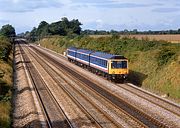 |
Even during their final months in the Thames Valley someone obviously cared enough to authorize the repainting of a number of Class 117 units. L406 (51383, 59493 & 51341) ambles along the relief line at Shottesbrooke with the 10:12 Reading to Paddington Network SouthEast service on 5 September 1992. By this date Class 165 Turbo units were rapidly being introduced to replace these elderly Pressed Steel units which had held sway on the route since the early 1960s. |
|
 |
L406 (51341, 59493 & 51383) approaches Wanborough on 17 July 1993 with the late running 2V13 17:30 Guildford to Reading Network SouthEast service. It is passing one of the characteristic Southern Region substations, that supplies 750V DC to the third rails. Wanborough station is actually in the village of Flexford. |
|
 |
L406 (51383, 59493 & 51341) calls at Blackwater station on 17 July 1993 with the 2O42 18:05 Reading to Guildford Network SouthEast service. Although the small industrial building on the left still exists, the larger one on the right has been replaced by a multi-storey car park. |
|
 |
L407 (51342, 59494 & 51384) is accelerating away from Wolvercote Junction in this 27 March 1982 view, and is just over a mile from its destination, as it works the 2A79 07:50 Moreton-in-Marsh to Oxford service. I doubt if you will see many pictures taken from this vantage point, and there is certainly no possibility now, as the public footpath from which it was taken was closed decades ago. Also, the whole area is now a jungle of trees. As can be seen here, in the early 1980s a clear view of the 1930s built A40 bridge was possible, with the brick building visible through the arch marking the location of Wolvercote Junction, where the Cotswold and Banbury lines meet. Note that in 1982 the up relief line was still laid with vintage 95lb per yard pre-war bullhead track. |
|
 |
L407 (51384, 59494 & 51342) arrives at Shipton station on 12 June 1982 with the Cotswold Line Promotion Group's Oxford to Matlock 'Cotswold - Derwent Special'. This was the second of the CLPG's very successful railtours, and while the sight of a Class 117 unit stopping at Shipton was commonplace at the time, the same could certainly not be said of Matlock! The diminutive waiting shelter with its slightly over the top awning disappeared shortly after this photo was taken, as did the GWR concrete name board posts. Although impossible to see from this angle, the one on the left still retained the large 'Shipton for Burford' sign at this time. |
|
 |
The Pressed Steel company produced two classes of DMU during the late 1950s and early 1960s at their factory at Linwood, in Scotland - the three car Class 117s and the single car Class 121s. The Class 121s were effectively a Class 117 DMBS vehicle with a cab at both ends. As both types were allocated to the Western Region, there were various occasions when they operated together. Such was the case on 1 December 1983, when Class 117 L407 (51342, 59494 & 51384) and Class 121 L134 (55034) worked the 2A57 11:55 Oxford to Paddington service, seen here passing South Moreton (Didcot East). |
|
 |
L407 (51342, 59494 & 51384) passes Hinksey on 3 March 1984 with the 2A65 12:35 Oxford to Paddington service. It's hard to believe now that in the 1980s the footbridge over the line at the north end of Hinksey Yard offered such a completely uninterrupted view of the Oxford skyline. Note the crane in the background, at work on the construction of Oxford's ice rink. |
|
 |
L407 (51342, 59494 & 51384), Class 121 L121 (55021) & L413 (51391+59501+51349) pass St Georges on 20 April 1985 with the Monmouthshire Railway Society 'Maerdy Gras' railtour. As the name suggests, this tour visited Maerdy Colliery, a well as Cwm Colliery, Blaengarw, Onllwyn, Aberpergwm and Cynheidre. This is a type of railtour that has all but disappeared from the national network. The use of lengthy DMU formations to traverse branch and freight only lines was an ideal low cost solution, although of course not very popular with haulage enthusiasts! |
|
 |
L407 (51342, 59494 & 51384) passes Cornbury Park on 7 June 1986 with the 2B55 09:23 Oxford to Hereford service. It will shortly be calling at Charlbury station, which is just out of sight, around the corner. Note that the DMBS vehicle has acquired a non-standard additional electfrication warning flash in the centre windscreen, which is partly obscuring the destination blind. |
|
 |
L407 (51384, 59494 & 51342) passes Daylesford on 18 July 1986 with the 2B50 07:00 Oxford to Hereford service. Although the view from this farm access and footpath bridge is still OK for afternoon pictures, the same cannot be said for a morning shot, and it is no longer possible to take a picture like this. The small bushes in the foreground have grown considerably, and now include a few full size trees, which completely block this view. |
|
 |
L407 (51384, 59494 & 51342) leaves Oxford station on 1 August 1986 with the 2C07 08:47 Oxford to Paddington service. Less than two months after the launch of Network SouthEast, there is unsurprisingly very little evidence of the new sector, with only a few locomotives and units in the new colour scheme. Blue and grey units such as this would still be commonplace for some time. |
|
 |
L407 (51342, 59494 & 51384) pulls out of Radley station on 27 August 1987 with the 2C68 17:45 Reading to Oxford Network SouthEast service. It is notably how few passengers there were in the 1980s compared to today's rejuvenated station. Apart from the NSE red lampposts, little investment had taken place at the station for years, and by 1987 it was looking quite run down. The dog seems happy enough though! This view clearly shows that the down platform was formerly an island, with the west face serving the Abingdon Branch. |
|
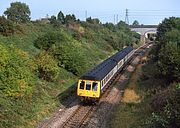 |
L407 (51342, 59494 & 51384) passes Aldington with the 12:26 Oxford to Worcester Shrub Hill service on 3 October 1987. This is one of the very few railway pictures that I took on what was at the time regarded as the finest quality 35mm colour transparency film - Kodachrome 25. Apart from the fact that ISO 25 is a ridiculously slow speed for use with a moving subject, I could only detect the tiniest improvement in quality over the much more usable Kodachrome 64. Of course if you really wanted an improvement in quality in those days, you used a large format camera, which is why a lot of the pictures on this website are taken with a Pentax 6x7. |
|
 |
L407 (51384, 59494 & 51342) passes the site of Coates goods station on 4 October 1987 with the 2B49 14:58 Swindon to Worcester Shrub Hill service. In the 1980s the wide open area that was once the location of a goods shed and quarry siding, was often used as a sort of unofficial place to watch trains go by, which explains the family group in the background. The station originally opened as Tetbury Road passenger station in 1845, but closed to passengers in 1882 with the opening of nearby Kemble station. It survived as a goods only station until 1963. |
|
 |
L407 (51342, 59494 & 51384) passes Waltham St Lawrence on 5 March 1988 with the 2F29 09:49 Paddington to Reading Network SouthEast service. For many years these Paddington local trains were covered by table 117 in the national railway timetable, which was highly appropriate, as generally they were worked by these Class 117 DMUs. |
|
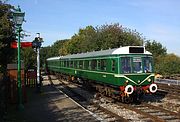 |
The Epping Ongar Railway's hybrid Class 117/121 unit arrives at North Weald station on 24 September 2017 with the 2E02 10:03 Epping Forest to North Weald service, during the line's Diesel Gala. The leading vehicle is Class 117 DMS 51384, with Class 121 DTS 56287 behind. Note the incorrect use of a M prefix to the number. This vehicle was part of Western Region set L407, and would have carried the number W51384. |
|
|
51384 & 56287 stand at North Weald station on 24 September 2017, having just arrived with the 2E02 10:03 Epping Forest to North Weald service. The second day of the Epping Ongar Railway's Diesel Gala was blessed with an almost completely sunny day. |
||
 |
After having arrived with the late running 2E18 13:23 service from Epping Forest, Class 117/121 hybrid unit 51384 & 56287 prepares to swap platforms at North Weald station on 24 September 2017, prior to working the 2E21 14:00 departure to Epping Forest, during the Epping Ongar Railway's Diesel Gala. |
|
 |
More DMU misinformation at Oxford on 4 September 1982. L408 (51343, 59495 & 51385) enters the station from the carriage sidings, ready to form the 2A75 07:45 departure to Reading. I hope the driver changed the Paddington destination to Reading before the train left, although it would seem logical to alter it before coming into the station. The brief burst of sunshine is illuminating the old water tower in the background, which at this time was one of the last vestiges of the old Oxford (81F) depot. |
|
 |
One clean and one not so clean Class 117 DMU at Hinksey on 3 March 1984. L408 (51385, 58495 & 51343) & L418 (51397, 59507 & 51355) near journey's end with the 2A18 11:01 Paddington to Oxford service. It's been many years since the view of the allotments and lake was as clear as this! |
|
 |
L408 (51343, 59495 & 51385) passes Hinksey Yard on 8 February 1986 with the 2A36 12:49 Paddington to Oxford service. This panoramic view of the north end of the yard gives a good view of the fan of sidings. In the 1980s this location was unobstructed by trees, which would now cause a February view such as this to be largely in shade. Also, the vegetation in the background has now grown considerably, mostly blocking this view of Hinksey Lake and New Hinksey church. |
|
 |
L408 (51343 & 59495) & Class 121 55027 (L127) head away from Dunstall Bridge, Moreton-in-Marsh on 20 August 1986 with the 2A56 16:46 Hereford to Oxford service. With two DMBS vehicles, there would have been plenty of potential bike storage, unlike the virtually non-existent provision on the Cotswold Line's current Class 800 DMUs. |
|
 |
L408 (51343, 59495 & 51385) accelerates away from Langley station on 6 November 1986, as it heads west along the Great Western Mainline with the 2F37 12:34 Paddington to Reading Network SouthEast service. This is the only time that I visited this particular location. |
|
 |
L408 (51385, 59495 & 51343) accelerates away from Charlbury station on 8 May 1987 with the 2A12 07:45 Moreton-in-Marsh to Reading service. This viewpoint is now obscured by trees, and the DMU has been scrapped, but happily Charlbury's Brunel designed wooden station building, which can be seen in the background, still survives. |
|
 |
L408 (51343, 59495 & 51385) waits for passengers at Moreton-in-Marsh on Sunday 7 August 1988 prior to working a revised shuttle service to Oxford, the line to the north of Moreton-in-Marsh being closed for engineering work. Someone obviously is a keen gardener here. The well stocked flower border and the GWR seat in the background adds to the nostalgic scene, although the Network SouthEast livery of the DMU brings the scene back to the 1980s! |
|
 |
L408 (51343, 59495 & 51385) moves from the double track section of the Cotswold Line, onto the long single track section at Ascott-under-Wychwood on 7 August 1988. The line north of Moreton-in-Marsh was closed for Sunday engineering work, and so this is the 2Z?? 12:00 Moreton-in-Marsh to Oxford shuttle service. |
|
 |
L408 (51385, 59495 & 51343) heads north from Oxford on 23 June 1989. There are a couple of unanswered questions here. Why is the destination blind showing 'Oxford', when it has clearly just left Oxford (the station can just be seen in the background). Also, what exactly is the working? There is nothing in the working timetable, either passenger or empty stock, anywhere near this time. It could possibly be the extremely late running 2H60 17:56 Oxford to Banbury Network SouthEast service, but that was specifically booked for a Class 101 at the time, having a note in the working timetable to that effect. Also note that although there are three Class 47s in the remains of Oxford shed, all the carriage sidings, on both sides of the lines, are completely empty. |
|
 |
L408 (51385, 59495 & 51343) passes South Moreton (Didcot East) on 24 October 1989 with the 2C27 12:15 Oxford to Reading Network SouthEast service. Not much survives from this view. The DMU has been scrapped, the gas holder has gone, and Didcot Power Station was closed in 2013. More importantly, the view itself has disappeared under a sea of 25Kv wires. |
|
 |
L409 (51386, 59496 & 51344) passes the south end of Hinksey Yard on 28 November 1981 with the 2A57 11:55 Oxford to Paddington service. This wide view shows just how open the view towards Oxford was in the 1980s. The footbridge across the yard visible in the background can barely be seen from this location now. |
|
 |
A perfect length train for this particular vantage point! L409 (51386, 59496 & 51344) passes Finstock station on 22 August 1985 with the 2B68 16:10 Oxford to Hereford service. This view shows the diminutive station as it existed from 1971 until 1986, with the former up platform serving the single track. The remains of the down platform can clearly be seen in the foreground, with the overgrown ash covered surface, and sleeper built edging. A year after this picture was taken, the track was slewed into the centre of the formation, and a new platform built on the west side of the line. There was no thought in the 1980s that the line would ever be redoubled, so all this work would have to be done again if the this section of the line was ever to redoubled. |
|
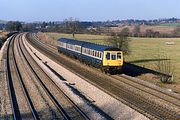 |
L409 (51386, 59496 & 51344) passes Lower Basildon on 25 January 1986 with the 2A45 12:49 Didcot Parkway to Paddington service. The car driving across the field looks a little suspicious, as a farmer would normally being using a Land Rover! |
|
 |
L409 (51344, 59496 & 51386) passes the resident Shetland Ponies at Lyneham on 4 April 1986, as it accelerates away from its last stop at Shipton station with the 2B60 16:35 Reading to Moreton-in-Marsh 'all stations' service. Although the ponies in the foreground make for an ideal photographic composition, the fact that they are black, and standing in an unfortunate area of shadow does not really help! I would have liked to have taken this picture with my Pentax 6x7 for improved quality, but there is no way that the medium format camera's limited depth of field would have allowed me to get both the train and the foreground in focus! |
|
 |
There were some quite long distance DMU workings over the Cotswold Line in the 1980s, not really the kind of train that the high density Pressed Steel Class 117s were designed for. L409 (51386, 59496 & 51344) passes Churchill Heath on 9 April 1986 with the 2A48 16:37 Hereford to Reading service. This was my first visit to this location, which became one of my favourite Cotswold Line vantage points, despite the long walk across the fields! |
|
 |
L409 (51386, 59496 & 51344) runs over newly laid track at Chilson on 26 April 1986 with the 2B52 09:23 Oxford to Hereford service. This is yet another case of a completely useless destination being displayed. Not only is it going the wrong way for Didcot to be the destination, but it hasn't even come from there! A similar viewpoint to this three decades later would consist primarily of bushes, and virtually no railway! The almost completely clear grassy banks seen here have been replaced by a thicket of vegetation, that due to Network Rail's utter neglect, has become almost shaped to the loading gauge by the passing trains! |
|
 |
L409 (51386, 59496 & 51344) calls at Ascott-under-Wychwood station on 10 May 1986 with the 2B72 16:35 Reading to Moreton-in-Marsh service. This station had a much better weekend service in the 1980s compared with today. In 1986 there were two trains in each direction on a Saturday, but now there are none! |
|
 |
L409 (51386, 59496 & 51344) passes Hinksey Yard on 21 June 1986 with the 2C30 18:03 Didcot Parkway to Oxford service. The red brick bridge in the background has subsequently been rebuilt, but lives on in the name of the local Redbridge Park & Ride and waste recycling centres. |
|
 |
L409 (51344, 59496 & 51386) passes Brimpton on 12 May 1987 with the 14:43 Reading to Newbury Network SouthEast service. This location is actually nearer to the village of Midgham than Midgham station is. The station actually being in the village of Woolhampton! |
|
 |
L409 (51386, 59496 & 51344) slowly moves off from platform 2 at Oxford on 24 July 1990 with the 2C66 17:35 Reading to Bicester Town Network SouthEast service. All three vehicles of this set are no more, although each met its end at a different location. 51386 was initially preserved, but was cut up at Dereham in 2002, likewise 59496 was at first saved, but then was cut at Rotherham as late as 2008. 51344 was disposed off at MC Metals, Glasgow in 1999. Note the newly completed station building and footbridge (which replaced the original subway). |
|
 |
L409 (51386, 59496 & 51344) passes Hinksey Yard on 19 January 1991 with the 2C41 13:51 Banbury to Reading Network SouthEast service. 1991 was the last full year that these Pressed Steel units had the monopoly of these Thames Valley local services. After over three decades of faithful service, they would soon be replaced by the new Class 165 Turbo units. |
|
 |
A very unusual working at Foxhall Junction, Didcot, on 12 March 1991. L409 (51386, 59496 & 51344) joins the Great Western Mainline, after traversing the normally freight only curve from Didcot North Junction, with what is presumably a special ECS working. These Class 117 units were an everyday sight just the other side of the bridge in the background, as they worked most of the Paddington to Oxford local trains through Didcot station. However, they very rarely passed this spot, which is why I have included this picture, despite the awful dull foggy conditions. |
|
 |
An interesting historic DMU view at Didcot on 31 July 1992, showing two Class 117 sets, both unusually running as two car units. This was at the very end of the Class 117's domination of the Thames Valley services out of Paddington, with the then new Class 165s rapidly taking over. L409 (51386 & 51344) pulls out of the station with the 2C60 17:05 Reading to Oxford Network SouthEast service, whilst directly behind it, L411 (51388 & 51346) arrives with the 2C57 17:22 Oxford to Reading. Note how L409 is displaying Reading, instead of Oxford on its destination blind. 47323 is parked in the yard, with the Great Western Society's Didcot Railway Centre in the background. |
|
 |
A late summer evening at Ascott-under-Wychwood with the setting sun giving an orange tint to the clouds. L410 (51387, 59497 & 51345) comes off the double track section after being held for the 1C74 18:00 Paddington to Hereford service, worked by 50038. The unit is working the early running 5A09 19:15 Moreton-in-Marsh to Oxford (not Paddington, as displayed in the windscreen!) empty stock, with the guard obviously enjoying the view from the front! It had earlier worked to Moreton-in-Marsh as the 2B48 15:29 ex Paddington, which at the time was an unbalanced working. The date is 6 June 1979 and this is one of my very few pictures of a Class 117 (or any other type of DMU!) in the short lived white with blue stripe livery. |
|
 |
L410 (51387, 59497 & 51345) stands at platform 2 at Oxford station on 7 January 1984, having just arrived with the 2A76 09:09 Reading to Oxford service. Taking nearly an hour to cover the 27 miles between the two towns, and stopping at every station, this train was obviously to be avoided if you wanted a speedy journey to Oxford! The platform awning behind the unit dates from the 1971 rebuilding of the station. |
|
 |
The guard already has his door open as L410 arrives at Honeybourne on 22 June 1985 with the 2A62 09:01 Paddington to Worcester Shrub Hill service. Normally this unit would comprise vehicles 51345, 59497 & 51387, but quite clearly the centre car has been replaced by a Class 101 trailer. These substitutions were usually only very temporary, often lasting no more than a couple of weeks, until the defective coach could be repaired. This was clearly the case here, as I have been unable to find any other pictures of L410 running in this condition. |
|
 |
After taking the conventional picture of L410 arriving at Honeybourne on 22 June 1985 with the 2A62 09:01 Paddington to Worcester Shrub Hill service, I couldn't resist taking this picture of the train leaving the station, as it shows just how rural and basic Honeybourne station used to be. Houses now occupy the field on the left, and the car park has been extended over the land where the dog walkers are. As the Vauxhall Cavalier is mine, the only rail passenger's car is the Talbot Sunbeam. This late 1970s car was slightly unusual for a small hatchback, being rear wheel drive. Also slightly unusual is the unidentified Class 101 trailer taking the place of 59497 in the centre of the DMU. The other two vehicle are: 51387 & 51345. |
|
 |
An impressive Pressed Steel DMU combination at West Drayton on 6 November 1986. L410 (51387, 59497 & 51345), L425 (51405 & 59515) & 55029 (L129) heads towards London with the 2A15 07:14 Reading to Paddington Network SouthEast service. Ordinarily this would be two three car Class 117 units, but as L425's DMBS vehicle (51363) is obviously undergoing repair, 'Bubble Car' Class 121 55029 is deputising. Not much difference really, as a Class 121 is essentially a Class 117 DMBS with an extra cab! 47100 can be seen in the background, waiting to follow, light engine. |
|
 |
L410 (51387, 59497 & 51345) accelerates away from West Drayton station on 6 November 1986 with the 10:14 Maidenhead to Paddington Network SouthEast Service. On the right can be seen the Grand Union Canal which runs parallel with the railway for over a mile at this point. The canal predates the railway by several decades, opening (as the Grand Junction Canal) in 1805. |
|
 |
L410 (51345, 59497 & 51387) runs along the down relief line at Langley on 6 November 1986 with the 2F42 14:03 Paddington to Maidenhead Network SouthEast service. It has just called at Langley station, which can be seen in the background. The large building on the right is Clare House, a large brick built office building, which the letting agent says was constricted in 1989. It looks pretty solid in this 1986 view! |
|
 |
L410 (51387, 59497 & 51345) passes South Moreton (Didcot East) on 8 November 1986 with the 12:42 Didcot Parkway to Paddington Network SouthEast service. All this is now history. The power station, the DMU and even the viewpoint have all been consigned to history. Interestingly, the three vehicles of this particular unit were broken up in three completely different locations: East Ham, Margam and Glasgow! |
|
 |
The sheep are undisturbed, as L410 (51345, 59497 & 51387) rattles past Lyneham on 7 May 1987 with the 2B60 16:40 Reading to Moreton-in-Marsh all stations service. Surprisingly, this location is still relatively clear of vegetation, although a conifer plantation has been planted on the other side of the line, and this now dominates the background. |
|
 |
L410 (51345, 59497 & 51387) leaves Kingham station on 8 May 1987 with the 2B60 16:23 Oxford to Hereford service. Unfortunately this excellent viewpoint is no longer accessible, and in fact most things in this picture have now changed beyond recognition. The car park has been extended, and an industrial estate is now situated between the station and my viewpoint. The GWR corrugated iron hut just visible above the DMU has gone, as has the GWR footbridge, replaced by a more modern design. The track is no longer vintage jointed bullhead rail, and the trees on the left have grown a lot higher. Also, the white Vauxhall Cavalier, which was my car at the time, expired spectacularly the following year later at 137,000 miles. |
|
 |
The oilseed rape field makes a dazzling foreground to this view of L410 (51345, 59497 & 51387) approaching Culham on 12 May 1987 with the 2C16 07:30 Reading to Oxford Network SouthEast service. This was unusually running 20 minutes late, something that would become a lot more common three decades later, under franchise operator's GWR tenure! |
|
 |
L410 (51387, 59497 & 51345) passes Hinksey Yard on the evening of 6 May 1988 with the 2C64 17:10 Reading to Oxford Network SouthEast service. It is just crossing one of several streams that link the Hinksey Stream (a backwater of the River Thames) with the main course of the River Thames. This whole area is criss-crossed by numerous small streams, which explains why the locality is so prone to flooding. |
|
 |
L410 (51345, 59497 & 51387) arrives at Oxford on 16 May 1990 with the late running 2C66 17:35 Reading to Bicester Town Network SouthEast service. This view has now been completely obliterated by trees. Even in 1990 the vegetation along the edge of the graveyard on the right was becoming a nuisance. In the early 1970s there was a clear low angle viewpoint from the cemetery of trains leaving the station and passing under the footbridge. Unfortunately this was before I took up photography! |
|
 |
L410 (51387, 59497 & 51345) approaches Culham on 4 July 1990 with the 2C27 10:48 Oxford to Reading Network SouthEast service. Typical British summer weather, but with so much of interest happening in those days, days off work had to be used for photography wherever possible, despite the conditions! |
|
 |
Temporarily running as a two car unit, L410 (51387 & 51345) gets the 'feathers' for the Bicester line, as it heads north from Oxford on 7 September 1991 with the 2C32 10:30 Reading to Bicester Town Network SouthEast service. Oxford North Junction is just beyond the Aristotle Lane footbridge in the background, and the unit will diverge off into the trees on the right. |
|
 |
The old order at Mill Lane, Islip on 7 September 1991. L410 (51387 & 51345) passes over the little used level crossing with the 2C37 11:57 Bicester Town to Oxford Network SouthEast service. The venerable Class 117 units were replaced by Turbo units the following year, but the road user operated level crossing survived for another couple of decades. With the rebuilding of the line as a through route to London via Bicester, this crossing was permanently closed, and a footbridge provided a short distance to the north. |
|
 |
L411 (51388, 59498 & 51346) passes through Shipton station on 22 July 1980 with the 2A97 17:41 Worcester Foregate Street to Didcot service. The Great Malvern destination blind is clearly no help to anyone! The last remnants of Shipton station's former goods yard can be seen in the foreground. The concrete coal staithes were removed shortly afterwards, and the whole grass covered area that was formerly a siding was converted into a coal park for the flour mill that dominates the background. |
|
 |
L411 (51346, 59498 & 51388) crests the summit of the 1 in 37 Lickey Incline at Blackwell on 20 March 1982, as it works the 2M72 12:44 Hereford to Birmingham New Street service. Trains were descending the bank just as slowly as the ones coming up on this occasion, due to the very obvious recent track replacement. |
|
 |
The driver of L411 (51388, 59498 & 51346) rolls a cigarette, as the unit passes Chilson on 23 March 1982 with the 2A79 07:50 Moreton-in-Marsh to Oxford service, although the destination blind has other ideas! Although colour light signals had been installed as far as Ascott-under-Wychwood in 1973, the steam age telegraph poles survived here for a number of years, although by 1982 they had been felled. Several of them can be seen lying in the grass by the side of the line. |
|
 |
L411 (51346, 59498 & 51388) passes South Moreton (Didcot East) on 1 December 1983 with the 2A28 12:01 Paddington to Oxford local service. It is just about to be overtaken by the late running 1B68 12:05 Paddington to Bristol Temple Meads HST. The area of wasteland behind the DMU is the site of Moreton Sidings, a wartime marshalling yard. |
|
 |
L411 is pictured at Culham on 5 May 1984, with just 51346 of 51346, 59498 & 51388 visible in this view. It is working the 2A21 14:50 Oxford to Paddington service, which should in theory have been formed of L403 & L572. Although this picture might give the impression of a local train stopped in the station, it is in fact a non-stop service, so considerable luck was required to press the shutter at exactly the right moment, with very little warning of its approach! |
|
 |
L411 (51346, 59488 & 51388) passes Badgeworth on 16 February 1985 with the 10:47 Birmingham New Street to Bristol Temple Meads service. A little out of the ordinary at the time for a Reading allocated Class 117 to be working this service. A Tyseley Class 116 would have been more normal. |
|
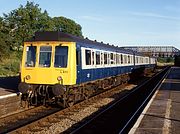 |
L411 (51388, 59498 & 51346) stands at Kingham station on the sunny evening of 23 July 1985 with the 2A50 19:14 Moreton-in-Marsh to Didcot service. Three decades later, the bullhead track, Class 117 DMUs and the original GWR footbridge have all gone. |
|
 |
L411 (51346, 59498 & 51388) emerges from the mist at Chilson on 28 June 1986 with the 2B55 09:23 Oxford to Hereford service. For many years the solitary dead tree in the field was a landmark at this location. It is long gone, but in any case tree growth along the lineside now hides the field from view anyway. |
|
 |
L411 (51388, 59498 & 51346) passes Ascott-under-Wychwood's leaning down starter signal on 19 July 1986 with the 2B55 09:23 Oxford to Hereford service. This was Ascott-under-Wychwood's sole remaining semaphore signal at the time. |
|
 |
L411 (51388, 59498 & 51346) passes South Moreton (Didcot East) on 24 October 1989 with the 2C33 13:21 Oxford to Reading Network SouthEast service. This used to be an excellent location for photography, apart from the fact that there was no pavement, and the road traffic was fairly continuous! |
|
 |
L411 (51388, 59498 & 51346) leaves Radley station on 13 May 1990 with the 2C60 16:55 Reading to Oxford Network SouthEast service. The following year a huge radio mast was placed near the end of the down platform, completely ruining this photographic vantage point. In the background is Lock Wood, which is on the steep escarpment on the south side of the River Thames. It is now slightly misnamed, as there hasn't been a lock in the area since the eighteenth century. |
|
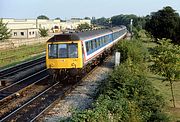 |
L411 (51346, 59498 & 51388) approaches Oxford on 18 July 1990 with the 2C66 17:35 Reading to Bicester Town Network SouthEast service. The industrial estate in the background occupies the site of the former Great Western Railway goods yard. The large goods shed was demolished in 1983, but a few sidings survived a little longer. |
|
 |
L411 (51346, 59498 & 51388) runs through the cutting at South Moreton on 15 August 1991 with the 2C56 16:30 Reading to Oxford Network SouthEast service. The bridge in the background was replaced in 2009, and in 2016 this view was lost due to the Great Western Mainline electfrication programme. |
|
 |
L411 (51388 & 51346) passes Didcot North Junction on 31 July 1992 with the 2C56 16:30 Reading to Oxford Network SouthEast service. It is unusually running without its centre trailer (59498), and for some reason has had the front set number over painted in non-standard white characters. |
|
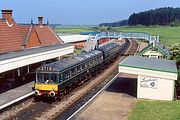 |
The two surviving vehicles from former Western Region set L411 (51388 & 51346) arrive at Weybourne station on 2 May 1998 with 14:00 Sheringham to Holt North Norfolk Railway service. Note that at this time only one platform was in use. This station was famously used for the filming in 1973 of the 'Royal Train' episode of 'Dad's Army'. |
|
 |
The former Western Region set L411, minus the centre trailer composite coach is seen here in use on the North Norfolk Railway on 2 May 1998 with DMS 51388 leading and DMBS 51346 at the rear. It is passing Sheringham Golf Course with the 16:00 Sheringham to Holt service. Subsequently the unit moved to the Swanage Railway. It is pictured here repainted into late 1960s condition with a small yellow warning panel replacing the original 'speed whiskers' and the roof all over black instead of the original white ends. |
|
 |
Former Western Region set L411 (now running as a two car unit with just 51388 & 51346) accelerates away from Sheringham on 2 May 1998 with 17:00 Sheringham to Holt service. It's new home on the North Norfolk Railway is certainly well away from anywhere it would have visited whilst in BR service. Note the signal with route indicator and high mounted shunt signal. |
|
 |
The early morning fog on 23 March 1982 has just started to clear (at least in the foreground), as the first northbound passenger train of the day over the Cotswold Line passes Chilson. L412 (51389, 59499 & 51347) is working the 2B08 06:04 Reading to Great Malvern service. The only thing that survives in this view, apart from the actual route of the line, is the rear DMBS vehicle, 51347. The PW hut, dead elm tree, and recently chopped down telegraph poles have all disappeared, and the single track of bullhead rails has now been replaced by two lines of continuously welded rails. Most importantly, the view no linger exists, due to Network Rail's total lack of lineside maintenance. The bushes now brush the sides of the trains at this point! |
|
 |
L412 (51347, 59499 & 51389) heads away from the camera at Ruscombe on 28 May 1983 with the 2A28 12:01 Paddington to Oxford service, just as 47507 slowly coasts into view with the late running 1V15 08:20 Liverpool Lime Street to Paddington train. The 47's engine was shut down, and this picture captures it as it gradually loses speed, before coming to a halt a couple of hundred yards further on. Failures were dealt with much more speedily in those days, and within the hour 47232 had arrived to drag the train off towards Paddington. |
|
 |
L412 (51347, 59499 & 51389) passes through the snowy Cotswold landscape near Evenlode on 16 February 1985 with the 2B06 08:08 Oxford to Moreton-in-Marsh service. Despite this train only operating for a short distance over the southern section of the Cotswold Line, it was not a truly local service, as it did not call at any of the smaller stations, stopping only at Charlbury and Kingham. |
|
 |
On a bitterly cold 8 February 1986, L412 (51347, 59499 & 51389) passes the site of Hinksey North signal box at the north end of Hinksey Yard, near Oxford with the 2A62 09:01 Paddington to Oxford 'all stations' service, while in the background L416 (51353, 59505 & 51395) heads towards the capital with the 2A87 10:15 Moreton-in-Marsh to Paddington service, also an 'all stations' train. It is worth noting that despite the atrocious weather both these trains were running exactly to time, something which is very unlikely to happen on today's railway in such conditions! Note the crudely applied spot welded panel on the former headcode box on the front of L412. |
|
 |
L412 (51389, 59499 & 51347) leaves Moreton-in-Marsh station on 26 May 1986 with the 2A56 16:46 Hereford to Oxford service. In the other platform is a West Midlands interloper. Instead of the usual Reading allocated Class 117, the 2B20 16:40 Reading to Moreton-in-Marsh is Tyseley's Class 116 set TS 613 (53863, 59594 & 53916). |
|
 |
L412 (51347, 59499 & 51389) runs through South Moreton cutting under a cloudless blue sky on 6 August 1988 with the 2C46 15:10 Reading to Oxford Network SouthEast service. This was a perfect location to photograph trains in those days, with a bridge parapet that was so low that it provided a convenient seat. The replacement bridge has ridiculously high parapets. |
|
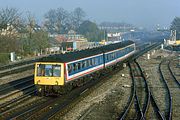 |
L412 (51347, 59499 & 51389) leaves Oxford station on 5 November 1988 with the 2C19 09:05 Network SouthEast service to Reading. Note that the station and the background are still shrouded in the early morning fog, whilst the sun has broken through in the foreground. |
|
 |
L412 (51347, 59499 & 51389) passes Lower Basildon on 11 February 1989 with the 2C27 12:24 Oxford to Reading 'all stations' Network SouthEast service. This was one of those fortunate days when there was masses of clouds about, but all the trains came in sunshine. If only that happened all the time! |
|
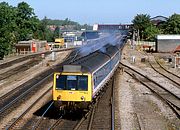 |
412 (51389, 59499 & 51347) leaves Oxford station on 26 May 1990 with the 2C27 10:48 Network SouthEast service to Reading. Unusually the unit is not displaying the normal L prefix to the set number, indicating it was a London allocated set (actually based at Reading). |
|
 |
L412 (51389 & 51347) approaches Wolvercote Junction on 20 June 1991 with the 2C70 19:20 Oxford to Banbury Network SouthEast service. Despite it being just a day away from the longest day, the sun has all but faded out into high cloud in the west. L412's centre coach (59499) is obviously away undergoing repair, but a two car unit is usually sufficient for the Banbury service, as can be seen from the number of empty seats on this occasion. |
|
 |
L412 (51347 & 51389) leaves Oxford station on 28 June 1991 with the 2C11 07:42 Network SouthEast service to Reading. The unit is unusually running as a two car set, but there cannot have been much wrong with the centre vehicle (59499), as it only appears to have been short formed for a couple of weeks. I have not been able to find any other pictures of it running as a two car set, other than the one I took of it a week earlier. |
|
 |
L412 (51389, 59499 & 51347) passes through Sonning cutting on 26 March 1992 with the 2A38 09:38 Reading to Paddington Network SouthEast service. The group of daffodils brightens up the trackside on a dull and wet morning. Apart from a couple of last minute visits in 2016, just prior to electfrication, this is unfortunately the only other occasion that I visited this iconic location. |
|
 |
L412 (51347, 59499 & 51389) passes the hangars of the former RNAS Culham on 13 May 1992 with the 2C69 19:51 Oxford to Reading Network SouthEast service. Oxfordshire is a long way from the sea, but Royal Naval Air Service Culham, was a Fleet Air Arm station, otherwise known as HMS Hornbill! |
|
 |
This DMU is formed from vehicles from two different former Western Region sets. DMBS 51347 (seen leading here) came from set L412, and DMS 51401 came from set L421. Whereas the other two vehicles from set L412 have been scrapped, all three vehicles of set L421 are still in existence. 51347 & 51401 are pictured passing milepost 42, on the Nene Valley Railway near Castor with the 10:40 Wansford to Peterborough service on 19 March 2000. |
|
 |
L413 (51349, 59501 & 51391) passes Lyneham on 19 April 1982 with the 2B60 15:31 Paddington to Moreton-in-Marsh service. This view looks a little different today, with a plantation of trees in the field on the left, and the demolition of the farm building on the right. |
|
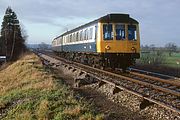 |
L413 (51349, 59501 & 51391) comes off the double track section of the Cotswold Line at Ascott-under-Wychwood on 2 January 1983 with the 2A75 09:32 Worcester Shrub Hill to Reading service. At this time the Cotswold Line was a relative backwater, with low passengers numbers and the sparse train service principally operated by these DMUs. Few could have foreseen the dramatic increases in passengers numbers in the following decades. |
|
 |
Sunshine and shadows at Oxford station on 7 January 1984. L413 (51349, 59501 & 51391) sets off for London with the 2A39 09:55 Oxford to Paddington service. The station building on the right dates from the early 1970s, and replaced a large wooden Great Western Railway structure. It itself was replaced in 1990 by a much more elaborate building. |
|
 |
L413 (51391, 59501 & 51349) passes Hinksey Yard on 7 January 1984 with the 2A28 12:01 Paddington to Oxford service. Note the non standard headcode blanking plate on the leading vehicle. The rails in the foreground were destined for track relaying on the Cotswold Line. |
|
 |
L413 (51391, 59501 & 51349) passes Appleford Crossing Signal Box on 12 September 1985 with the 2A85 08:05 Hereford to Paddington service. Concead behind the unit is the junction for the line to Appleford Sidings. This is now a stone terminal, but in 1985 was also a destination for containerised waste trains from London. |
|
 |
L413 (51349, 59501 & 51391) passes underneath the farm occupation bridge at Daylesford on 8 May 1986 with the 2A62 19:20 Moreton-in-Marsh to Oxford service. The spring of 1986 was very cold, and plant growth was very late as a result. With hardly any signs of spring greenery, this pictures looks more like it was taken in early April, or even late March! |
|
 |
L413 (51349, 59501 & 51391) and another unidentified Class 117 unit accelerate slowly away from West Drayton station on 6 November 1986 with the 2A21 09:20 Reading to Paddington local service, and are rapidly being overtaken by the 1A21 06:00 Milford Haven to Paddington HST. |
|
 |
L413 (51349, 59501 & 51391) accelerates away from Cholsey station on 18 February 1990 with the 2C46 15:15 Reading to Bicester Town Network SouthEast service. Only the centre trailer of this unit managed to survive the cutter's torch, as both the driving cars were cut up at MC Metals, Glasgow, in June 1995. |
|
 |
L413 (51349, 59501 & 51391) approaches Oxford station along the bi-directional line on 18 July 1990 with the 2C62 17:22 Reading to Oxford Network SouthEast service. Only the centre trailer has survived from this DMU. Both power cars were scrapped at MC Metals, Glasgow, in June 1995. |
|
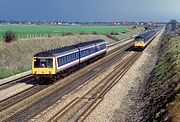 |
Network SouthEast trains, both slow and fast, at Shottesbrooke on 26 March 1992. L413 (51391, 59501 & 51349) runs along the down relief line with the 2F39 12:17 Paddington to Reading service, while 47838 is rapidly gaining on it with the 1F20 12:30 Paddington to Newbury train. Normally of course this would be a NSE allocated Class 47/4 or 47/7 with appropriate coaches, but on this particular occasion an InterCity liveried Class 47/8 and matching stock is being used. |
|
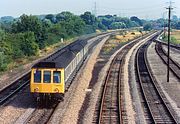 |
L414 (51392, 59502 & 51350) passes Hinksey Yard on 28 July 1983 with the 2A56 15:01 Paddington to Oxford service. There are two principal differences between this view, and the same scene over 30 years later. Firstly, in the 1980s the yard was usually completely empty, and secondly, the grassy area where the tracks diverge hadn't become an impenetrable jungle of bushes! |
|
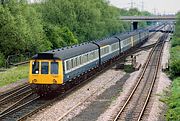 |
L414 (51392, 59502 & 51350) & L415 (51393, 59503 & 51351) pass Hinksey on 12 May 1984 with the 2A18 11:01 Paddington to Oxford service. The track on the right leads into Hinksey Yard, and just visible in the distance underneath the bridge, is Kennington Junction, where the Morris Cowley line diverges to the left. |
|
 |
L414 (51350, 59502 & 51392) arrives at Charlbury on 22 July 1986 with the 2A56 16:46 Hereford to Oxford service. This location is now once again double track, after the 2011 reinstatement of the second track undid the early 1970s rationalisation of the Cotswold Line. |
|
 |
It's hard to believe that the view south from the A40 roadbridge at Wolvercote Junction was ever as open as this! L414 (51392, 59502 & 51350) heads north on 7 April 1988 with the 2M71 17:50 Oxford to Banbury service. Not only was this an excellent viewpoint, but there was a view of southbound trains from the footpath crossing that can just be seen in front of the A34 Oxford bypass bridge in the background. That crossing was deemed too dangerous and was closed many years ago. |
|
 |
Windsor Castle forms the impressive backdrop, as L414 (51350, 59502 & 51392) pulls out of Windsor and Eaton Central station on 6 January 1991 with the 2C37 13:01 departure for Slough. As it was a bitterly cold day, I can't quite see why the local youth population should be so keen to be hanging out of the windows! Unfortunately I took very few pictures on the Thames Valley branch lines in the first generation DMU era. |
|
 |
Instantly recognisable because of its non-standard yellow window modification. L414 (51350, 59502 & 51392) passes Hinksey Yard on 1 August 1991 with the 2C41 13:15 Banbury to Reading Network SouthEast service. |
|
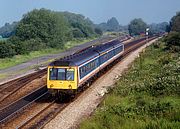 |
L414 (51350, 59502 & 51392) passes the south end of Hinksey Yard on 5 July 1991 with the 2C21 09:02 Bicester Town to Reading Network SouthEast service. DMBS 51350 seems to have had a window modification, with what looks like yellow paint applied to the upper section, presumably as some kind of permanent sun visor. |
|
 |
L414 (51350, 59502 & 51392) trundles along the former LMS Cambridge to Oxford line at Charlton-on-Otmoor on 5 July 1991 with the 2C35 11:51 Bicester Town to Oxford Network SouthEast service. This location has changed out of all recognition since this picture was taken. What was then a sleepy backwater, with just a few freight trains, and the infrequent Oxford to Bicester DMU shuttle, has now been transformed into a highly engineered mainline with a soon to be instigated intensive passenger service. Gone is the vintage bullhead track, to be replaced by double track, with some major engineering works, including several new bridges. |
|
 |
L415 (51393, 59503 & 51351) arrives at Kingham station on 16 January 1982 with the 2A29 13:30 Hereford to Reading service. Clearly visible in the background is the embankment of the Banbury to Cheltenham direct railway, with the abutments of the removed bridge still free of vegetation. Although conifers have been planted on the course of the line that curved away to the right to meet the direct line, the site of the mirror image curve on the left can still be seen as the snow covered open area at the foot of the embankment. |
|
 |
L415 (51351, 59503 & 51393) accelerates away from Charlbury station on 26 April 1984 with the 13:30 Great Malvern to Oxford service. This viewpoint is from the road that leads to Cornbury Park, a large 17th century country house in extensive parkland on the edge of Wychwood Forest. Charlbury church can be seen on the horizon, and yes it does appear to have a slight lean to the right when viewed from this spot! Note the recently relaid track. |
|
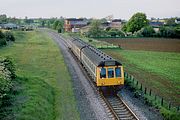 |
L415 (51351, 59503 & 51393) passes the site of Chipping Campden station on 2 June 1984 with the 2A75 18:45 Hereford to Paddington service. Anyone contemplating the full journey could knock nearly an hour off the trip by changing into a faster train at Oxford, otherwise the journey took 4 hours 34 minutes! The flat grassy area on the left is the site of the formerly rail connected Chipping Campden Gas Works. |
|
 |
L415 (51393, 58503 & 51351) passes the splendid set of lower quadrant signals at Worcester Shrub Hill on 24 November 1984, as it arrives at the station with the 2M28 11:58 Great Malvern to Birmingham New Street service. Amazingly, these signals are not only still in place over 30 years later, but are not scheduled to be replaced until after 2040! |
|
 |
A once commonplace Western Region suburban scene at Maidenhead, as a pair of Class 117 DMUs meet on 22 November 1986. L415 (51351, 59503 & 51393) waits in the bay platform with the 10:14 Maidenhead to Paddington 'all stations' service, while on the left L425 (51405, 59515 & 51363) & hidden from view on the rear, L130 (55030) arrive with the 09:54 Reading to Paddington, which will now only call at Slough and Ealing Broadway en-route to the capital. This is very early Network SouthEast days, with all the units still in blue and grey livery, but with the distinctive bright red lampposts already in evidence. |
|
 |
L415 (51351, 59503 & 51393) approaches Didcot North Junction on 9 December 1986 with the 2C07 08:47 Oxford to Didcot Parkway Network SouthEast service. The work stained appearance of this DMU is in marked contrast to the following 2A85 08:08 Hereford to Didcot Parkway service. |
|
 |
L415 (51351, 59503 & 51393) passes Ascott-under-Wychwood on 15 February 1987 with the 2A32 09:32 Worcester Shrub Hill to Oxford service. Although not immediately apparent from this angle, the train is just moving from the double to the single track section of the Cotswold Line. The point rodding can be seen in the foreground, leading to Ascott-under-Wychwood Signal Box. |
|
 |
A picture that for me suns up the Cotswold Line in the 1980s. L415 (51351, 59503 & 51393) leaves Kingham station on 8 May 1987 with the 2B60 16:40 Reading to Moreton-in-Marsh 'all stations' Network SouthEast service. The lack of cars, even in the then very small car park is evident, as is the lack of passengers. There are however quite a few spectators, including a family group near the old lamp hut on the left. The father's choice of viewpoint for his young son, on top of the signal cabinet, would certainly be frowned on today! The large area of rough grass in the foreground is now an additional car park. |
|
 |
A golden DMU. L415 (51351, 59503 & 51393) passes South Moreton (Didcot East) on 28 August 1987 with the 2C49 18:20 Bicester Town to Reading Network SouthEast service. This is one of my better glint pictures, as often either the glint doesn't show up enough, or the sun gets so low that something partly shades the train. With this one I particularly like the way the unit stands out amid the dark surroundings. |
|
 |
L415 (51393, 59503 & 51351) pulls out of Radley station on 30 June 1988 with the 2C67 19:25 Oxford to Reading Network SouthEast service. A standard going away shot, but why are the marker lights not showing red? Although the upper of the two bulbs in the DMU's light housing normally displayed red, they are clearly not here! With Oxford showing in the destination blind, a casual glance might indicate a wrong line working, although of close inspection reveals no driver! |
|
 |
L415 (51393, 59503 & 51351) stands at Theale station on 30 September 1989 with the 2B13 07:57 Bedwyn to Reading Network SouthEast service. Theale station is a little way south of the village, and is now completely surrounded by industrial estates, some evidence of which can even be seen in this 1980s view. |
|
 |
L415 (51393, 59503 & 51351) passes White Waltham on 6 January 1991 with the 2F33 10:40 Paddington to Reading Network SouthEast service. 1991 would be the last full year that these venerable Pressed Steel units had the virtual monopoly of these trains. Introduced over three decades earlier, they had spent their entire life on the route. Originally in green livery, they were later painted blue, white and blue, blue and grey, and they finally ended up in this colourful paint scheme. |
|
 |
L415 (51393, 59503 & 51351) approaches Radley on 9 July 1991 with the 2C66 17:35 Reading to Bicester Town Network SouthEast service. The wide area of ballast in the foreground marks the course of the former Abingdon branch line, which ran parallel with the mainline for over half a mile, from its junction at Radley station. |
|
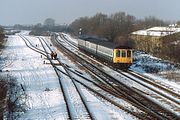 |
L416 (51395, 59505 & 51353) passes the southern end of the snow covered Hinksey Yard on 12 February 1985 with the 2C19 14:45 Oxford to Didcot service. You would expect a short distance local service like this to call at all stations, but this one didn't, it was non-stop Oxford to Didcot. |
|
 |
L416 (51353, 59505 & 51395) passes Hinksey Yard on 22 October 1985 with the 2A53 14:06 Oxford to Paddington service. The dark green colour of the containers parked in the foreground immediately gives away the fact that this is an MoD train, although the 'Royal Corps of Transport' lettering on the sides leaves no doubt! The containers are part of the 6A50 13:56 Bicester to Morris Cowley Speedlink working. |
|
 |
L416 (51395, 59505 & 51353) leaves Radley station on 7 December 1985 with the 2B62 09:01 Paddington to Worcester Shrub Hill service. This was a seriously slow journey, taking 3 hours 17 minutes, with numerous stops. Either the Cotswold line was closed for engineering work on this occasion, resulting in the train terminating at Oxford, or more likely the Oxford destination blind is a red herring, as was often the case in the first generation DMU era, After all, I have pictures of trains on the Cotswold Line showing Salisbury and Radyr in their destination blinds! |
|
 |
L416 (51395, 59505 & 51353) leaves Charlbury station on 8 February 1986 with the 2B56 08:08 Oxford to Moreton-in-Marsh service, which means that the Reading being displayed in the rear windscreen is neither the destination or the point of origin! Admittedly this is a going away shot, but I wasn't going to pass up the opportunity of a picture in the sunshine and snow. |
|
 |
L416 (51395, 59505 & 51353) passes Hinksey on 8 February 1986 with the 2A87 10:15 Moreton-in-Marsh to Paddington service. The area of waste ground behind the rusty fence is the site of the former Oxford gas works, operated by the Oxford Gas, Light & Coke Co. This was rail connected, and employed its own small saddle tank locomotives. |
|
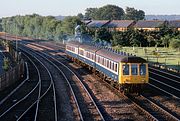 |
L416 (51395, 59505 & 51353) arrives at Oxford on 1 August 1986 with the 2B50 06:04 Reading to Worcester Foregate Street Network SouthEast service. The inaccurate destination blind is not at all unusual, although in this case the train does actually call at Oxford. On other occasions I have seen DMUs on the Cotswold Line displaying such unlikely destinations as Salisbury and Radyr! The unit is approaching Oxford station along the up relief line, so that it can call at platform 1, as per the working timetable. |
|
 |
L416 (51395, 59505 & 51353) approaches Honeybourne with the 14:28 Oxford to Hereford service on 25 April 1987. At this time there were only five trains in each direction on this line on a Saturday, something the single track railway could easily cope with. However, traffic levels increased over the years to the extent that in 2009 work was started to reinstate the double track at this point, although the scheme is bizarrely leaving sections of single track at either end of the route. |
|
 |
L416 (51353, 59505 & 51395) arrives at Finstock station on 6 July 1987 with the 2A12 07:45 Moreton-in-Marsh to Oxford Network SouthEast service. This was the only up train of the day to call at this diminutive station, and considering the village is some distance away, it seems to be attracting a reasonable number of passengers. Note the new platform, which had recently been built on the site of the old sleeper and ash built down platform. Until 1985 the former up platform had been in use. |
|
 |
DMBS 51353, formerly from set L416, and latterly 117301, stands at Leeming Bar on 20 July 2025. When the DMU arrived at the Wensleydale Railway the original intention was to restore it to operational condition, but as it was in poor condition it was sold to the Leeming Bar Community Hub. |
|
 |
L417 (51396, 59506 & 51354) leads an unidentified classmate, which is still in the white with blue stripe 1970s livery, past Hinksey Yard on 5 July 1980 with the 2A72 10:59 Paddington to Oxford service. A loaded rake of MGR hoppers is the only occupant of the yard. These were sometimes staged here en-route to Didcot Power Station in the early 1980s. The most noticeable thing about this picture is how open the view is, with hardly any bushes yet growing on the disused parts of the wartime marshalling yard. |
|
 |
L417 (51354, 59506 & 51396) calls at Ascott-under-Wychwood in dramatic lighting on 17 September 1983. It is working the 16:33 Reading to Moreton-in-Marsh local service, one of only two down trains to call at the station at that time. With such a complete covering of dark clouds I was fortunate that the unit's arrival corresponded with the sun dropping out of the cloud into a small gap just above the horizon. An excellent piece of timing, which given the infrequency of trains on the Cotswold Line (certainly in the 1980s) was very lucky indeed! |
|
 |
Bridge repairs at Radley on 1 December 1983 require traffic lights to be in place, but there are minimal signs of health & safety fencing alongside the railway, unlike what would be required today. L417 (51396, 59506 & 51354) passes through with the 2A39 09:55 Oxford to Paddington service |
|
 |
L417 (51354, 59506 & 51396) comes out of the shadows and into the light, as it passes Hungerford Common on 3 September 1984 with the 09:52 Bedwyn to Newbury service. Note the position of the former down loop on the left, which at this time had been truncated to the short siding visible in the background. |
|
 |
L417 (51354, 59506 & 51396) heads away from the camera at Cassington on 16 May 1986 with the 2A50 15:44 Great Malvern to Didcot Parkway service. The bridge in the background was formerly a farm occupation bridge, but now serves a sewage works. Near the bridge the track suddenly swerves to the right. When the Cotswold Line was singled in 1971, the position of the new single line altered at various places on the route. |
|
 |
L417 (51396, 59506 & 51354) pulls away from Kingham station on 16 April 1987 with the 2B20 16:40 Reading to Moreton-in-Mash Network SouthEast service. Trains generally seemed to run to time on the Cotswold Line in the 1980s, unlike the terrible timekeeping when First Great Western took over several decades later. However, this was running 15 minutes late, and with the train booked to call at all the line's minor stations, there would be very little possibility of making up time. The unit returned from Moreton an hour later. |
|
 |
L417 (51354, 59506 & 51396) arrives at Kingham station on 16 April 1987 with the 2A62 19:18 Moreton-in-Marsh to Oxford Network SouthEast service. This view clearly shows the remains of the old Banbury to Cheltenham line platforms on the right. A forest of trees now covers this area. |
|
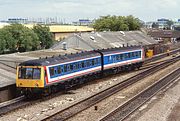 |
Under the watchful eye of a rail worker, L417 (51396 & 51354) crosses from the up relief to the down relief line at West Drayton on 22 June 1991. Both relief lines were closed for engineering works to the east of this point. The unit had just arrived as the 13:20 Slough to West Drayton Network SouthEast service, and would later depart as the 13:45 West Drayton to Slough. Note that the unit is running without its centre car (59506). |
|
 |
L417 (51354, 59506 & 51396) departs from a seemingly deserted Didcot station on 31 July 1992 with the late running 2C62 17:21 Reading to Oxford 'all stations' Network SouthEast service. With the coming of the then new Turbo units, L417 would lose its centre trailer and become L720, and start working Gospel Oak to Barking services. |
|
 |
L418 (51355, 59507, & 51397) arrives at Evesham station on 20 March 1982 with the 2C72 09:05 Oxford to Hereford service. The brick bridge which carries the High Street over the railway makes an excellent frame for the picture, and avoids having lots of blank featureless sky in the view. |
|
 |
L418 (51355, 59507 & 51397) passes Hinksey Yard on 3 March 1984 with the 2A13 13:40 Oxford to Paddington service. This location is now completely overgrown, but in the early 1980s there was an unobstructed view of the western edge of Oxford. Even the old footbridge at Osney Lane (just south of the station) can just be seen to the right of the signal gantry in the background. |
|
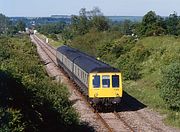 |
A going away shot that neatly illustrates the limited capacity of the Cotswold Line in the 1980s. L418 (51397, 59507 & 51355) approaches Ascott-under-Wychwood on 15 June 1985 with the 2B56 08:08 Oxford to Moreton-in-Marsh service. This was running ten minutes late, which has resulted in the 1A17 07:00 Hereford to Paddington being held at the signal in the background. The yellow cab of 50035 Ark Royal can just be seen sticking out from the bushes in the far distance. |
|
 |
L418 (51397, 59507 & 51355) & L579 (51065, 59424 & 51319) prepare to depart from Sharpness on 26 October 1985 with the Monmouthshire Railway Society 08:10 Cardiff Central to Portishead 'Sharpness Shunter' railtour. The rail employee walks back along the length of the train to unclip the points after it has left, before heading off home on his motorbike. I can't remember now why I only photographed this tour at Sharpness (unless it was the dire weather), as it also visited Sudbrook, Caerwent, Tytherington, Gloucester Docks and Portishead! | |
 |
Viewed from the very tall Grintleyhill Bridge, L418 (51355, 59507, & 51397) passes Combe on 7 December 1985 with the 2B60 09:01 Didcot to Hereford service. This is an interesting view, as it shows much more of the surrounding countryside than can be seen today. Just visible in the background where the track disappears from view is the wooden platform of Combe Halt (which the train has not called at). Combe Mill, which houses a Victorian steam sawmill, and is now open to the public, is in the background, and the River Evenlode completes the scene, as it meanders through the fields in the middle distance. |
|
 |
The driver of L418 (51397, 59507, & 51355) gives the window a quick clean whilst sat in the bay platform at Reading on 22 November 1986. The unit is about to work the 2A69 08:54 service to Paddington, which I rode on as far as Maidenhead. This of course is in the good old pre-privatisation days, which probably explains why the station lights are still on despite it being a bright sunny day. BR having as about as much financial accountability as the MoD! |
|
 |
L418 (51397, 59507 & 51355) leaves Charlbury station on 9 May 1987 with the 2A50 15:44 Great Malvern to Didcot Parkway service. The bridge in the foreground crosses the River Evenlode. The Cotswold Line crosses over the River Evenlode numerous times between Hanborough and Moreton-in-Marsh. |
|
 |
L418 (51397, 59507, & 51355) pulls away from Ascott-under-Wychwood station on 30 June 1987 with the 07:45 Moreton-in-Marsh to Reading local service. Presumably the unit later worked on to Paddington which would make the destination blind correct, and yet the timetable shows it as a Moreton-in-Marsh to Oxford service, with a separate working onwards to Reading. The prominent 75mph restriction sign applies to the double track section which commences near the signal box in the background. The single line from here to Oxford is cleared for 90mph running. |
|
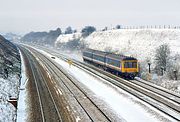 |
L418 (51355, 59507 & 51397) passes through a snowy landscape at South Moreton on 9 February 1991, as it runs along the up relief line with the 2C29 Didcot Parkway to Reading Network South East service. This was one of those trains that had a different departure time in the public timetable (11:45), compared to the working timetable (11:48). In either case, it was a few minutes late here, which is hardly surprising given the conditions. A purely local short distance Sunday train would probably be cancelled in such weather conditions nowadays. |
|
 |
L418 (51355, 59507, & 51397) prepares to stop at Radley station with the 13:15 Banbury to Reading Network SouthEast service on 11 December 1991. At this time the station still retained its original GWR footbridge, although minus its canopy. In December 2007 a new footbridge was installed in a slightly different position, after an intervening period when an ugly temporary footbridge was in use |
|
 |
L418 (51355, 59507 & 51397) passes Didcot North Junction on 22 April 1992 with the 2C26 09:00 Reading to Oxford Network SouthEast service. Just visible in the background is an unidentified Class 60, with an equally unidentified oil train train, possibly the late running 6A15 23:55 Waterston to Colnbrook. |
|
 |
L419 (51356, 59508 & 51398) passes Wolvercote Junction on 27 March 1982 with the 2V60 07:53 Banbury to Reading service. It has been a long time since its been possible to take an unshaded morning picture of a southbound train like this here! The bridge that the unit is crossing is over the Duke's Cut - a short canal linking the Oxford Canal to the River Thames. |
|
 |
L419 (51398, 59508 & 51356) pulls away from Charlbury station on 27 August 1983 with the 2C78 16:25 Oxford to Hereford service. If you think displaying Oxford in the destination blind is stupid when you are going to Hereford, just look at this. A good selection of classic 1970s cars can be seen in the car park, which at this time had yet to be extended. In 1983 this probably represents very nearly the busiest that Charlbury station ever got. Nowadays it would never be this quiet! |
|
 |
White out conditions at Kingham on 19 January 1985. L419 (51356, 59508 & 51398) arrives at the station with the 2B06 08:08 Oxford to Moreton-in-Marsh service. Note to modern train operators - despite the sub-zero temperatures and fog, along with the use of vintage rolling stock (even then), this train was running no more than a couple of minutes late. |
|
 |
A panoramic view from the bridge near Ascott Mill, showing L419 (51398, 59508 & 51356) heading towards Ascott-under-Wychwood on 15 June 1985 with the 2B60 09:23 Oxford to Hereford service. 50017 Royal Oak can just be seen in the far distance waiting to access the single line to Oxford. This wide view includes both Ascott-under-Wychwood church (on the left), and just visible amid the trees on the right, the spire of Shipton-under-Wychwood church. |
|
 |
L419 (51398, 59508 & 51356) pulls away from Moreton-in-Marsh station on Sunday 16 June 1985 with the 2A81 15:55 Worcester Shrub Hill to Oxford service. Surprisingly, a quarter of a century later not much has changed here, and although no longer working on the national network, all three vehicles of this DMU survive in preservation. Apart from the bushes in the background growing taller, the only significant changes are the replacement of the footbridge and the signal box windows. Even all this vintage bullhead track has survived! |
|
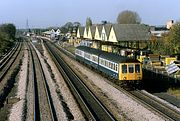 |
L419 (51398, 59508 & 51356) accelerates away from West Drayton station on 6 November 1986 with the 2A32 09:42 Didcot Parkway to Paddington Network SouthEast service. It would return an hour and a half later with the 2F35 11:49 Paddington to Didcot Parkway train. |
|
 |
L419 (51356, 59508 & 51398) accelerates away from Langley station on 6 November 1986 with the 2F35 11:49 Paddington to Didcot Parkway Network SouthEast service. I had also photographed the unit a little earlier, as it headed into London with the 2A32 09:42 Didcot Parkway to Paddington train. |
|
 |
L419 (51398, 59508 & 51356) rattles along the up relief line at South Moreton on 8 November 1986 with the 10:21 Oxford to Paddington 'all stations' service. Although the Network SouthEast brand had been in use since the summer, virtually no DMUs had received the new colour scheme at the time this picture was taken. Most acquired the discreet stickers that can just bee seen on the centre trailer of L419, but it would be a long time before there were substantial numbers of units in NSE livery. |
|
 |
It's been a very long time since the view was anything like as open as this at Didcot North Junction. L419 (51356, 59508 & 51398) approaches the junction on 9 December 1986 with the 2C09 09:21 Oxford to Didcot Parkway service. The Paddington destination blind is a red herring! Unusually, this short distance working ran non-stop. Appleford Signal Box can be seen in the distance, directly above the DMU. |
|
 |
L419 (51398, 59508 & 51356) passes Chilson on 22 March 1987 with the 2A32 09:32 Worcester Shrub Hill to Oxford service, which was the Cotswold Line's first up train of the day on a Sunday at this time. This was definitely one of those occasions when the going away shot was the one to take. Not only is the lighting angle better, but the sunlit foreground contrasts markedly with the dark background. It seems like the Charlbury area is about to get some rain! |
|
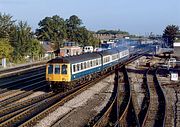 |
L419 (51398, 59508 & 51356) leaves Oxford station on 4 September 1987 with the 2C11 08:10 Oxford to Reading service. This was over a year after Chris Green's launch of the Network SouthEast brand, but like a lot of Thames Valley rolling stock, the only indication of the new regime is the application of a sticker, which can just be seen on the side of the centre coach. |
|
 |
L419 (51356, 59508 & 51398) stands at Oxford station's platform 1 on 21 October 1988, prior to working the 2C39 15:21 Network SouthEast service to Reading. Note the two styles of platform awning. The modern one behind the DMU dates from the 1971 rebuilding, while the one in the background is a GWR original. |
|
 |
L419 (51398, 59508 & 51356) accelerates away from Culham station (just visible on the extreme right) on 10 July 1991. It is working the 2C66 17:35 Reading to Bicester Town Network SouthEast service. This location gives a good view of the some of the buildings on the former wartime Culham airfield (now an industrial estate). Note the two different types of hangar. The larger ones are the Pentad type, with two smaller blister types in front. |
|
 |
After its displacement from Thames Valley services in the early 1990s, L419 (51356, 59508 & 51398) had its centre car removed and acquired the set number L702. In this form it is seen accelerating away from Woburn Sands station with DMBS 51356 leading on 29 August 1998. It is working the 09:50 Bletchley to Bedford service. This picture demonstrates one of the main problems with the Pentax 6x7 camera when used with a 200mm lens. The unit is absolutely pin sharp, but the level crossing in the background isn't due to the very limited depth of field. |
|
 |
A scene full of vintage infrastructure at Millbrook on 29 August 1998. L702 (51356 & 51398) arrives with the 11:50 Bletchley to Bedford service. Note the signalman waiting by the ground frame, ready to manually close the level crossing gates behind the DMU. |
|
 |
L702 (51398 & 51356) leaves Millbrook on 29 August 1998 with the 11:50 Bletchley to Bedford service. After taking a picture of the unit approaching the station, I couldn't resist this going away shot, as it includes the two semaphore signals in the background. These, along with all the others on the route have since been removed. |
|
 |
The 2C19 11:19 Wareham to Swanage service prepares to leave Wareham station on 8 July 2023. Class 117 51356 & 59486 are working with Class 121 'Bubbler Car' 55028. The most striking (literally!) difference between this train's journey over Network Rail metals, and the Swanage Railway, is the state of the lineside vegetation. Everything is neatly trimmed on the Swanage Railway, but on the Network Rail section nothing has been done for years, and in several places the DMU was hitting the overgrown bushes. This was not just on the former freight only Worgret Junction to Norden section, but on the main line as well! |